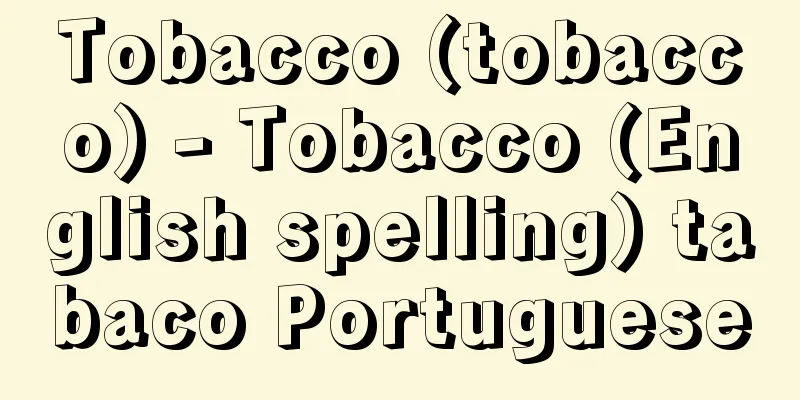Tobacco (tobacco) - Tobacco (English spelling) tabaco Portuguese

|
A perennial plant of the Nicotiana genus in the nightshade family (APG classification: Solanaceae). It is treated as an annual plant for cultivation. It is widely cultivated around the world for smoking. [Masatake Tanaka] Tobacco leafformThe stems grow to 2 meters in height and have alternate leaves about 60 centimeters long. The shape of the leaves varies by variety, from long spindle-shaped to long heart-shaped, but about 30 leaves grow on each stem, and about 10 to 20 leaves from the middle to upper part of the stem are harvested and used. There are also varieties in which the base of the leaf blade is not developed and looks like it has a petiole, and varieties in which the base of the leaf blade is developed and looks sessile. The flowers are tubular, gamopetalous, and come in white, pink, and reddish pink. There are five stamens and one pistil, and the tip of the corolla has five lobes. The seeds are small, measuring 0.7 to 0.8 mm in major axis and 0.5 to 0.6 mm in minor axis, and are slightly flattened egg-shaped, reddish brown or blackish brown, with wavy bumps on the surface. The leaves are dried to make cigarettes, cigars, and shredded tobacco for pipes and kiseru. [Masatake Tanaka] ClassificationThere are several cultivated species of Nicotiana plants, as well as wild species. Other cultivated species include N. rustica L., which is primarily used for nicotine extraction, N. tomentosa Ruiz et Pav., which is used for ornamental purposes, N. × sanderae W. Watson, and N. glauca Graham. The leaves of malt tobacco are yellowish and have long petioles, and as the name suggests, the tips are rounder and not sharper than those of tobacco. Although the quality is inferior to that of tobacco, it is precocious, so it was once cultivated in highlands and cold regions of South America, mainly in Mexico, as well as in Germany and Switzerland, but is now rarely used for smoking. The nicotine content of the leaves is higher than that of tobacco, so it is cultivated for nicotine extraction. Malt tobacco and Nicotiana are species with beautiful flowers, and in Europe and the United States they have been bred and are used in flower beds. Nicotiana glauca is also used as an ornamental plant. While ornamental varieties may be cultivated freely, in Japan the Tobacco Business Act (Law No. 68 of 1984) stipulates that only those who have signed a contract with Japan Tobacco Inc. may cultivate varieties for smoking purposes. [Masatake Tanaka] Origin and spreadThere are about 60 wild species in the genus Nicotiana, including diploid, tetraploid and aneuploid species. N. sylvestris Speg. et Comes., the tomentosa group ( N. tomentosa Ruiz. et Pavon, N. tomentosiformis Goodsp., N. otophora Grisebach), N. paniculata L., and N. undulata Ruiz. et Pavon are diploid species, while cultivated and malva species are tetraploid. Tobacco was first established by natural hybridization between the Silvestris species and one of the species of the Tomentosa group, followed by chromosome doubling. When artificially bred species were bred by crossing the Silvestris species with each of the species of the Tomentosa group, only the Otophora species showed seed fertility, and the Otophora species has a common distribution area with the Silvestris species. Therefore, it is highly likely that the Otophora species is another ancestor species of the Tomentosa group. Its place of origin is the Salta region in northern Argentina and the neighboring southern region of Bolivia, where both ancestor species are distributed. However, no wild species of this species have been found. Another cultivated species, the malva, is a tetraploid species that originated by natural hybridization between the diploid species of the paniculata species and the undulata species, followed by chromosome doubling. Its place of origin is presumed to be the common distribution area of both ancestors, the central Andes plateau of Peru and Bolivia at an altitude of 3,000 meters, especially on the western slope on the Pacific coast. Wild species of this species have been found in the arid areas of southwestern Ecuador at an altitude of 2,300 to 2,800 meters, and on the western side of the Andes on the border between Peru and Bolivia at an altitude of 2,000 to 3,600 meters. Of these two cultivated species, malva tobacco was established first, spreading north to Mexico, the southwestern and eastern to northeastern North America, and southern Canada. Later, tobacco cultivated for smoking today originated, replacing malva tobacco. This spread to both North and South America, and at the time of Columbus' "discovery of the New World" (1492), it was cultivated in more than 90% of the region except for northern North America and the southern tip of South America, and smoking was a common practice. It was first introduced to Europe in Spain in 1518. It was introduced to other European countries one after another in the second half of the 16th century. It was introduced to Turkey from Ecuador and Colombia in 1850, and Turkish leaf was established. It was first introduced to Asia by the Spanish in 1571 from Cuba to the Philippines. Today, the variety cultivated in the Philippines is called Manila leaf and is one of the superior varieties. It was introduced to mainland China in 1600 in Fujian via Taiwan, then spread to the southern and central parts of the mainland, and then to Burma (Myanmar). It was introduced to India by the Portuguese from Brazil in 1605, and was then introduced to Ceylon in 1610. It was introduced to Japan in the Keicho era (1596-1614) at Ibusuki Port in Satsuma (Kagoshima Prefecture), then to Nagasaki, and further to Uraga Port in the Horeki era (1751-1764), where it spread to cultivation throughout the country. Since then, the number of varieties has increased, and by the time of the transition to a monopoly system in 1897 (Meiji 30), there were 170 varieties. [Masatake Tanaka] VarietiesTobacco varieties vary in the aroma of the leaves, the smoking taste (called the aroma and flavor), elasticity, and burning properties, and therefore in their uses. Also, the optimum cultivation area is roughly determined by the type, and different cultivation and preparation methods are used for each type, from cultivation to the processing of the leaves after harvesting. The varieties are broadly divided into yellow, burley, and native varieties, as well as cigar and orient varieties, which are not cultivated in Japan. [1] Yellow tobacco is a variety whose leaves are hung in a drying room to dry, resulting in a vivid orange or pale yellow color. Native to North America, it is the most widely cultivated variety in the world. It was introduced to Japan after the Meiji period, and full-scale cultivation began in the Showa period, and it is cultivated widely from the Kanto region west to Okinawa. Japanese yellow tobacco varieties are broadly divided into four categories, from the first yellow tobacco to the fourth yellow tobacco, and the first, second, third, and fourth yellow tobacco varieties are currently cultivated. The first yellow tobacco is a semi-flavoring variety for cigarettes (a variety that is not the main flavor of cigarettes, but is similar to it). It is cultivated mainly in the Setouchi and Kyushu regions. The second yellow tobacco is a low-nicotine variety and a cigarette softener variety (also called a softener supplement, which improves the product's burn time and gives the product a firmness, and has a light taste and aroma and is not peculiar). It is cultivated in the Hokuriku region, the Chugoku and Shikoku regions, Kagoshima Prefecture, and Okinawa Prefecture. The third flue variety was once the standard variety and is used as a flavoring for cigarettes (it has an excellent and rich flavor). It is grown in the Kyushu region. The fourth flue variety is grown in the Kanto region. [2] Burley is a variety that was originally a mutation of a native American variety and has little chlorophyll. It has an excellent aroma and a unique taste, and is a flavoring variety for so-called American-type cigarettes. Full-scale cultivation in Japan began in 1938 (Showa 13), and is mainly grown in the Tohoku region. [3] Native species is a general term for varieties that have been cultivated in various parts of Japan since before the Meiji period, and varieties that have been improved based on those varieties. They have been cultivated since the Edo period, and there are many varieties, divided into five groups, Native species 1 to 5. Of these, Native species 2, 3, and 5 are commercially cultivated, while Native species 1 and 4 are no longer cultivated. The second native species, Matsukawa, is a mitigation variety for cigarettes and has the largest cultivation area of all the native species. Its main production area is Fukushima Prefecture. The third native species includes three varieties: Daruma, which is mainly produced in Tochigi Prefecture, Awa, which is mainly produced in Tokushima Prefecture, and Enshu, which is mainly produced in Shizuoka Prefecture. All of these are mitigation varieties for cigarettes. The fifth native variety, Shira-Enshu, was developed by crossing a burley with a native variety, and its plant shape, cultivation, and preparation methods are almost the same as those of the burley variety. It is a high-yielding variety with the flavor and aroma of the native variety. It is a milder variety for cigarettes, and is cultivated in various regions. The first native variety includes Suifu and Kokubu, which were used for shredded tobacco because of their particularly rich flavor and aroma, but cultivation of these varieties has ceased as demand for shredded tobacco has decreased. The fourth native variety is Nanbu, which is used for cigars and was primarily produced in Iwate Prefecture, but is no longer cultivated. [4] Cigar varieties are tobaccos used for cigars, and are characterized by their strong fermentation. Demand for cigars is high in Europe, and the main producing areas are Cuba and the Dominican Republic in the Caribbean, Florida in the United States, Wisconsin, Sumatra, the Philippines, and other places. [5] The Orient variety is native to the Mediterranean climate of Greece, Türkiye, and other places, and has a unique fragrance. It is difficult to cultivate in humid regions such as Japan. [Hoshikawa Kiyochika] CultivationTobacco seeds are very small, so they are sowed in water, with the seeds floating on water and scattered on the seedbed with water from a watering can. Tobacco seeds are photophilic, so they are not covered with soil, but rather covered with compost powder to the extent that the seeds are slightly hidden. The sowing period is from February to March. The temperature of the seedbed is kept at 20 to 25°C. The seeds germinate 5 to 7 days after sowing. When the seedlings have 3 or 4 true leaves, they are temporarily transplanted in a separate seedbed. In April, when the seedlings have grown to 8 or 9 leaves, they are transplanted in the main field with the soil surface covered with vinyl film. By July, the plants will have grown to a height of about 2 meters and begin to flower at the top of the stem. At the beginning or middle of flowering, the core of the stem is pinched off (called topping). This is an important task in tobacco cultivation, as the amount of nicotine and other components accumulated in the leaves depends on how deeply the top is pinched off. In other words, pinching off the core shallowly will result in less nicotine in the leaves, and pinching off the core deeply will result in more nicotine. Additionally, as the branch buds grow, the core-stopping effect is lost, so all branch buds that sprout from the base of the leaves are also removed. Growth regulators such as maleic hydrazide are also used to prevent these buds from growing. Immediately after top pinching, harvesting usually begins in mid-July, with about two leaves at a time being harvested every 5-7 days, starting from the lower leaves. Once the middle leaves have been harvested, the leaves above them mature at almost the same time, so for yellow varieties, 5-6 or 7-8 leaves can be harvested at once. For burley and native varieties, the upper leaves, 7-8 or 10-15 leaves, are harvested along with the stem. The harvested leaves are placed in the distribution process after undergoing a drying process. During drying, the polymeric compounds in the leaves, such as proteins and starches, break down, and the tobacco's flavor and aroma components are produced, so drying of leaves is a processing step that is more meaningful than simply drying. There are two main methods that are used, and there are different drying methods that are suitable for different types of tobacco. Bulk drying is used exclusively for drying flue-cured tobacco. This method involves forced circulation of hot air from kerosene or propane gas in a drying room where the leaves are hung, and the temperature is gradually increased from 36-38°C at the beginning to a maximum of 70°C, and the entire process takes about 120 hours. Burley and native varieties are dried using the air drying method (also called natural drying), in which the leaves are slowly dried over a period of 3-4 weeks at natural temperature, humidity, and ventilation. Diseases of tobacco include wilt and tobacco mosaic disease. Wilt is a major disease, especially in yellow-leaved varieties, but it can be controlled by cultivating resistant varieties and by disinfecting the soil with chloropicrin. Tobacco mosaic disease is caused by the tobacco mosaic virus, which once caused great damage, but due to interspecific hybridization with the closely related N. glutinosa L., which is resistant to the virus, current varieties such as Burley 21 and Shira-Enshu grown in Japan are no longer affected by it. [Hoshikawa Kiyochika] Production StatusLooking at the production situation in Japan (1984), the total cultivated area was 53,400 hectares and the harvest volume was 135,500 tons. The main production area is Fukushima Prefecture with 6,420 hectares, followed by Iwate Prefecture with 4,680 hectares, Kumamoto Prefecture with 3,930 hectares, Ibaraki Prefecture with 3,810 hectares, Kagoshima Prefecture with 3,600 hectares, Miyazaki Prefecture with 2,720 hectares, Aomori Prefecture with 2,610 hectares, and Niigata Prefecture with 2,200 hectares. In terms of varieties, yellow varieties account for 60% of the total. In addition to domestic production, there are also imports, of which imports amounted to about 70,000 tons, or 98 billion yen, in fiscal 1984. Imports of cigarettes totaled 7,024 million sticks, or 30.5 billion yen. The world's production situation (1984) is that the cultivated area is 4,155,000 hectares and the harvest volume is 6,205,000 tons. By country, China has 779,000 hectares and 1,526,000 tons, the United States has 323,000 hectares and 791,000 tons, India has 440,000 hectares and 497,000 tons, Brazil has 285,000 hectares and 415,000 tons, and the former Soviet Union has 180,000 hectares and 350,000 tons. Japan is the world's seventh largest cultivator, after Turkey. [Hoshikawa Kiyochika] Since the 2000s, the demand for tobacco has decreased due to the rise in health consciousness and the aging of smokers. In response to this situation, tobacco leaf production was adjusted in 2004 and 2012. In addition, the number of abandoned cultivation due to the aging of farmers and lack of successors has increased. As a result, the cultivated area and production volume have decreased significantly. Based on sales results to JT (Japan Tobacco Inc.), the cultivated area in 2018 was 7,065 hectares and the production volume was 16,998 tons. The main production areas are Kumamoto Prefecture (1,034 hectares), Aomori Prefecture (821 hectares), Iwate Prefecture (768 hectares), Fukushima Prefecture (262 hectares), and Akita Prefecture (240 hectares). In terms of variety, yellow varieties account for 69% of the total. Burley varieties are cultivated in the Tohoku region, yellow varieties in Western Japan, and both varieties in Kanto and Hokuetsu. Native varieties have not been produced since 2015. Total tobacco imports in fiscal 2017 were approximately 125,887 tons, worth 529.7 billion yen, of which 498 billion yen was for manufactured tobacco. Of the manufactured tobacco, 59.7 billion cigarettes, worth 293 billion yen, were made up of cigarettes, and the remainder was made up of heated tobacco products that use tobacco leaves, the proportion of which is on the rise. The world production situation (2017) is a cultivated area of 3,528,500 hectares and a harvest of 6,501,600 tons. By country, China has 1,081,400 hectares and 2,392,100 tons, India has 467,600 hectares and 800,000 tons, Brazil has 398,000 hectares and 880,000 tons, Indonesia has 185,700 hectares and 152,300 tons, Zimbabwe has 150,000 hectares and 181,600 tons, the United States has 130,000 hectares and 322,100 tons, and Japan has 7,600 hectares and 19,000 tons. [Editorial Department] History of SmokingUse of incense smokeHumans began to inhale smoke after they started using fire. Some plants release a pleasant fragrance when burned, and it was believed that this fragrant smoke not only gives people fresh energy and vitality, but also that it is inhabited by the spirits of gods. This belief is common to all countries of the world, and burning incense at religious events is an important ritual, and it was also necessary in magic because it has a fantastic mental effect. It has also been used as a medicine to treat illnesses. In Egypt around 3000 BC, it was believed that when incense was burned at the temple, the smoke would reach the gods in the sky and grant the king's wishes. In Greece around 700 BC, a priestess at the Temple of Apollo would inhale large amounts of incense smoke, and the mumblings she uttered when she lost consciousness were believed to be the words of the gods. The smoke filling the temple and creating a mystical atmosphere in this way was effective in enhancing faith. The Greek physician Hippocrates (c. 460-c. 375 BCE) believed that inhaling incense smoke was effective in treating gynecological diseases, and the philosopher Plutarch (c. 46-c. 120 CE) is said to have fallen into a state of ecstasy after smelling the smoke of burnt cannabis seeds. The Roman natural scientist Pliny the Elder (c. 23-c. 79 CE) believed that the smoke from dried holly was useful in treating asthma, and he had already described pipes for smoking. The Celts, who wielded power in Central and Western Europe around the 4th century BCE, made portable pipes out of bronze and cast iron and inhaled aromatic incense smoke. In Europe, the custom of smoking herbs predates the smoking of tobacco. [Tanaka Tomiyoshi] Mayans and TobaccoTobacco has been cultivated in South America, southern Central America, and the West Indies since before the Common Era, with the species Nicotiana tabacum L., which is good for smoking, and the species Nicotiana rustica L., which has small leaves and is pungent when smoked, as far as the Mississippi River basin in North America. The Mayans flourished before the Common Era and reached their peak around 500-600 AD. They were an intelligent people with a unique culture that developed astronomy, calendars, and hieroglyphics, and had religious beliefs that worshipped the sun and agricultural gods. They left behind temple ruins with stone carvings in their own style, unglazed tableware, and a codex (pictorial document) that served as a guide for their lives. Among these are paintings and stone carvings of gods, symbolized as human figures, smoking tobacco. The Mayans believed that the spirits of God resided in tobacco leaves because of the aroma and intoxication they got from smoking, and used tobacco leaves as sacred objects in religious ceremonies and offered incense smoke to temples. Smoking became the privilege of the priests, and the ramblings of those in a coma caused by heavy smoking were believed to be divine prophecies, and it was believed that the smoke exhaled by the priests would ward off evil spirits and cure illnesses. This custom eventually became a method of magic, and the components of the leaves were used for medicinal purposes. Mayan culture was gradually revealed after 1520, that is, after the Spanish conquered the region, but at that time the Mayans were already in decline, and sovereignty was taken over by the Toltecs from the north, followed by the Aztecs. The ritual methods differed depending on the ethnic group, but tobacco was an important offering to the gods for all ethnic groups. When a battle began, tobacco was offered at the temple to curse the enemy, and when the battle was over, tobacco was given to the heroes who had performed meritorious deeds, giving them the honor of smoking in public. Captives of the enemy were also given tobacco, and they were given the same when they were sacrificed to the gods. When a woman became pregnant, tobacco was presented to guests at a celebratory banquet, and the parents would stick tobacco on their bodies to pray for the safety of the unborn child. When a noble died, tobacco smoke was used to say goodbye, and after the funeral, a banquet was held where people enjoyed smoking tobacco. Tobacco was also used at the time of birth and death, as well as at the construction of temples and the completion of civil engineering works. When nobles, warriors, and armed merchants went on official trips, tobacco was distributed to those who were accompanying them when they departed and returned. However, tobacco smoking was generally restricted, and there were special exceptions for nobles, warriors, and the elderly, and no freedom to smoke for recreational purposes except at banquets and ceremonies. For medicinal purposes, powder, decoction, boiled leaf juice, ointment, and salve were used for wounds, tumors, ulcers, syphilis, coughs, colds, tonsillitis, asthma, headaches, toothaches, rheumatism, stomach problems, indigestion, and swelling of the uterus and spleen, and for suppositories, it was mixed with other ingredients or added alcohol. It was also used to exterminate mosquitoes and fleas, and to prevent bites from poisonous snakes, poisonous insects, and scorpions. [Tanaka Tomiyoshi] To EuropeOn August 2, 1492, with the support of the Spanish royal family, Columbus sailed west across the Atlantic Ocean in search of gold and spices, and landed on San Salvador Island in the Bahamas on October 12. He presented the islanders with glass beads and other gifts as a sign of friendship, and received local products from the island in return. Among them were several large dried leaves, and a few days later he received the same leaves on Santa Maria Island. His subordinates reported that the islanders on Cuba had lit sticks (cigars) and tobacco leaves (tobacco leaves) for incense in their hands, which was the first time that Europeans had ever known about tobacco. Through investigations by monks, engineers, doctors, and others who joined Columbus' second and subsequent expeditions, the actual situation of the West Indies, such as the customs of the people and the medicinal effects of tobacco, was gradually revealed. Spain also established a colony in Florida in the Americas in 1513, where they discovered pipe smoking among the natives, but in 1519 they reached the Yucatan Peninsula in Central America and destroyed the Aztecs in 1521. In the capital, the king was seen elegantly smoking a silver pipe, and in the shopping district, tobacco leaves, painted clay pipes, and tobacco flavorings were sold. As Spain's colonial expansion policy progressed, it was discovered that tobacco was called differently in different regions; in Cuba it was called "tobacco," in Haiti "kohaba," in Mexico "yetl," and in Brazil "petum." Tobacco cultivation began on the island of Cuba in 1535, and in the 1550s it was cultivated as an ornamental plant in seaside towns and parks in the home country. Since many cigar-smoking areas were in the colonies, primitive cigar smoking became a smoking custom in Spain, but this custom was not widely spread to other countries. Portugal was at the height of its prosperity during the Age of Discovery, and in 1499 it discovered a sea route to India that bypassed the Cape of Good Hope, making it one of the most prosperous trading nations in Europe, with trade reaching all the way to the East. In 1500, a fleet bound for the West Indies was hit by a storm on the way and washed up on the coast of Brazil, where it colonized the region. At that time, there were reports of indigenous people's customs, such as sorcerers smoking strange pipes made from gourds and performing spells. In the 1540s, colonists in the region traded with other countries, and it is said that tobacco was included in the trade. Portugal's encounter with tobacco was not as spectacular as Spain's, but the country did introduce tobacco to France, Italy, and the East. Since 1533, France has twice explored the mountainous region of Montreal via the Gulf of St. Lawrence in Canada in search of gold, and records of the expeditions include records of indigenous pipe smoking. Later, in 1559, Jean Nicot, the French ambassador to Portugal, presented tobacco seeds and leaves to the royal family of his country as a new medicine, and Queen Catherine used them for headaches, which drew attention to the plant. It is not clear when smoking began in France, but pipe smoking had become widespread by the end of the 16th century. When Louis XIII (reigned 1610-1643) ascended to the throne, he said that it was unsightly for aristocrats and high-ranking officials to exhale smoke from their noses, so snuff was used exclusively in the upper classes, and it was considered elegant for ladies to smoke it with an elegant hand. On the other hand, common people loved pipes, and smoking taverns (smoking clubs) were located all over the city, where people could smoke freely. In 1624, the government responded to the smoking epidemic by implementing a high tax policy, enriching the royal finances, but the prohibition on the sale of tobacco other than for medicinal purposes had a significant impact on national tax revenues, and the prohibition was eventually repealed. The people, who had been dissatisfied with the high tobacco tax for many years, were freed from it by the French Revolution in 1789, but prices soared due to unstable supplies caused by political instability, and the National Assembly was troubled by the decline in national revenues. In 1810, Napoleon, needing to raise funds for his continental campaign, reinstated the tobacco monopoly, a system that has continued to this day. Britain's overseas expansion was delayed, and began in the 1560s with a fleet led by Admiral Hawkins, who raided Portuguese territories in West Africa, plundering black slaves from slave traders and selling them to Spanish colonists in the Americas. They then raided French colonies along the coast of Florida, where they discovered pipe smoking among the natives, and brought back tobacco leaves and seeds. Admiral Drake often attacked Spanish ships sailing in the 1570s and plundered their cargo, which included tobacco leaves, and smoking was already known at that time. In the 1580s, Sir Water Raleigh ordered his captains to establish colonies in the southeastern part of North America, and occupied the Virginia region. The captain returned with the local people, who taught Raleigh about smoking through the tobacco they brought with them, and Raleigh quickly realized that tobacco had a promising future as a product. His pipe smoking made it a requirement of gentlemen in London society to smoke a pipe gracefully, along with dancing, horse riding, hunting, and playing karuta (card games), and he was often depicted satirically in illustrations. England acquired pipe-smoking areas in its colonies, so smoking was limited to pipes. Eventually, clay pipes began to be manufactured, and they were made of silver, wood, and even walnut shells. It was said that a morning puff from a silver pipe could cure headaches and toothaches and prevent the worsening of a cold. Even among working people, no one would go into a bar and order a drink immediately, but would first order a cigarette. Smoking clubs flourished, and strict club rules were established, such as members smoking more than three clay pipes at a time and not blowing smoke on others. Tobacco was initially imported from Spain, and when the cost of tobacco became too high, the government opposed smoking, leading King James I to write his famous Treatise on the Contravention of Tobacco (1604). However, when tobacco was imported directly from the Virginia colony, the import taxes enriched the national treasury, while the Virginia colony gained economic independence through tobacco production and export, laying the foundation for the founding of the United States. になったんです。 English: The first thing you can do is to find the best one to do. Not only that, in 1627, the government planned to increase the national revenue by taxing cigarettes. The method was an exclusive sales law that allowed individuals to pay contracts and to sell cigarettes in one move for a year, and in 1659 the Republic of Venice adopted a monopoly system using a "tobacco contract" in which individuals would be given exclusive rights to sell, including the import and production of cigarettes. になったんです。 English: The first thing you can do is to find the best one to do. In Prussia, where small princes were separated by small princes, the Supreme Prince Cologne investigated the smoking situation, and issued an edict saying that this evil practice would be banned and those who committed this practice would be punished by strict punishment. However, the smoking ban was not followed, and the lords and other common people would not let go of cigarettes. Friedrich I, who became King of Prussia in 1701, held a so-called "Tobacco Conference" in which piped cigarettes were used at conferences of senior officials. The next King Wilhelm I took the form of a club rather than a stiff meeting, and even a general or staff member in palaces, or even a palace, a general or staff member, later a scholar, ambassador of other countries, playmates, and clowns, making it a free official feast. On the tabletop, cigarettes were placed in baskets along with wine and meals, clay pipes were placed, and burned red peat was placed on a plate to ignite the pipes. The king levied taxes on tobacco sales, but in 1719 he handed over the rights to tobacco production to merchants in 1719, following the examples of various countries, and collected the rights every year and used them for military expenses. [Tanaka Tomiyoshi] To countries around the worldTobacco was transmitted to countries around the world by sea and land, but the route was transmitted by Portugal through Africa, Arabia and India to the East and Japan, the UK traveled from the Netherlands, the North Sea to the Baltic Sea and the Mediterranean to Turkey, and the Pacific to Australia and New Zealand, Prussia and Poland to northern Russia, Turkey to southern Russia, Russia to Siberia, and China to vast inland and Siberia. Here, the tobacco by sea and land became one, and it was brought from Siberia to the Eskimos in the far north, and some from Canada to the far north, and tobacco traveled around the world in the first century. Japan told Korea, but smoking equipment is often influenced by China due to its geographical relationship. になったんです。 English: The first thing you can do is to find the best one to do. Furthermore, the reason why Russia does not stop smoking is the harsh winter, as the warmth and euphoric effects of smoking encourage good sleep. になったんです。 English: The first thing you can do is to find the best one to do. There are dozens of tobacco nicknames, such as medicinal products, such as Hangon Sou (Hangon Sou), and Soushiso (Soushiso) for their deliciousness, and in China, there are many beautiful words about tobacco, which shows how much they were loved. [Tanaka Tomiyoshi] From pipe to sniffになったんです。 English: The first thing you can do is to find the best one to do. Sniffing became the fashion of the time, and became popular regardless of the rich or poor gender. Although Napoleon I (reigned 1804-1815) of France did not smoke, he liked sniffing and even carried a container with a portrait of his beloved wife, Josephine, even during the expedition. Portugal was introduced to the East, and was mainly used in India, China and Tibet, but became particularly popular in China. In 1715, a gift to the French Jesuit missionary Shin included a sniff and container, which was believed to be effective in treating colds, toothaches, asthma and other diseases, and spread throughout the country. The container was made of gold, silver, cobblestones, ivory, porcelain, and all kinds of substances from the mountains and seas, and was named a sniff pot. In 1869 (Meiji 2), the then Duke of Edinburgh of England presented to Emperor Meiji a gorgeous diamond-studded sniff pot, but it finally became unpopular in Japan. [Tanaka Tomiyoshi] From sniff to cigarsになったんです。 English: The first thing you can do is to find the best one to do. There was a constant recurring conflict between the people who smoked cigars as an expression of free thought and police officers who were cracking down on them. [Tanaka Tomiyoshi] Popularization in JapanMany of the literature describes the period when tobacco was introduced in Japan, such as the Genki and Tensho eras (1570-1592), or the Tensho eras or Bunroku eras (1592-1595), but there is no document to support this theory. However, according to classical literature, the crew of Nanban ships (Portuguese ships) who first introduced the tobacco by wrapping leaves and smoking them, but eventually they began to bring in a sucking tube. They said that it could be called that, and Japan began to make it from copper iron. In 1615 (Genwa 1), "This bamboo, which is used in the middle of the kiselle, is called lau." The Nanban ships, which traded supplies needed in Japan and supplies for Southeast Asia from Japan, entered Nagasaki, starting with Goa, India as the starting point, via Malacca and Macau.になったんです。 English: The first thing you can do is to find the best one to do. However, as mass imports and tobacco cultivation began in Japan, it soon spread to the common people. になったんです。 English: The first thing you can do is to find the best one to do. When urban tobacco shops flourished, they began to subcontract their chopping, put craftsmen in the store, or sellers began to sell to towns. Around Kansei (1789-1801), wooden carving machines were built to allow mass production, and in the production of tobacco leaf, packaged goods were moved to other countries. In cities, they skillfully combined leaves with different flavors from the region to produce different types of tobacco products, and products with different prices. Tobacco became a luxury item, and in the life of a life filled with joy, anger, sorrow and happiness, it became an essential item in households, as well as in storefronts, travel inns, social venues, and brothels. When Yokohama and other countries opened at the end of the Edo period, officials of the shogunate first smoked cigars through diplomatic negotiations, but even after the Meiji Restoration, officials first preferred cigarettes. In 1872 (Meiji 5), Tsuchida Yasugoro first produced cigarettes, and cigarettes became a symbol of civilization and enlightenment, and began to become popular along with clocks and perfumes. Iwatani Shokai released "Tengu Tobako" and spread the word "towel rolls" to the popular public, and the Murai Brothers Shokai released two-cut paper rolls, "Sunrise" and "Hero," and the promotional battle between the two represented the Meiji period of privately operated cigarettes. In 1876, the government levied taxes on tobacco, but there was a lot of tax evasion, and in 1898 it was exclusive to tobacco leaf in 1898. In 1904 (Meiji 37), there was a need to raise war expenses during the Russo-Japanese War, and there was a risk that the Murai Brothers' Shokai would join together with foreign tobacco capital to monopolize the Japanese tobacco market, so it was established by promulgating a monopoly system in which to manufacture and sell tobacco as a government company and profits were used as the revenue of the national treasury, and in 1985 it was established by the Tobacco Monopoly Bureau. [Tanaka Tomiyoshi] Modern tobacco productsTobacco spreadになったんです。 English: The first thing you can doになったんです。 English: The first thing you can do is to find the best one to do. The UK also began manufacturing to cigarettes in the 1850s, and this was introduced to the United States. In the 1860s, the tobacco industry was thriving, the mechanization of leaf tobacco truncating machines was carried out in the 1860s, and in 1889 a packaging machine for both Bonsack-type truncating machines (now "Peace" and "Hope" boxes), and in 1889 they successfully mechanized the production of double-cut paper rolls. After that, the production of cigarette rolls with mouths was also mechanized, but since the release of a filter with a filter connected to both slices as a mouthpiece in the 1950s, this has become the mainstream of cigarette cigarettes. In Japan, 97% of cigarettes are now included. Cigarettes were also produced in Western Europe, but pipe choppings and cigars were still used. However, cigarettes were excellent in terms of convenience in smoking, and demand grew rapidly after World War I. In Japan, the price of tobacco smoked tobacco was low, so cigarettes were considered luxurious, but after World War I, the demand for cigarettes increased, and in 1923 (Taisho 12), the production volume of cigarettes exceeded the production volume. Furthermore, in 1930 (Showa 5), both slices exceeded the production volume, and in 1970 (Showa 45), both slices exceeded the production volume of both slices. になったんです。 English: The first thing you can do is to find the best one to do. This is said to be because cigarettes need to be long to smoke while wearing gloves in winter. [Tanaka Tomiyoshi] Double sliced paper roll cigaretteThe ingredients used differ depending on the type and their composition, and each tastes different. [1] Virginia Blend It is mainly made from yellow leaves from the United States. These leaves drier rapidly through iron tube heat, leaving the sugar contained in the leaves without breaking down, making them sweeter to the touch and have a umami flavor. The beautiful golden color of the cut cut is beautiful, and is essential for smoking cigarettes. In various countries, these yellow-leaf seeds are grown in the products and are blended into products, but this distinctive feature is that they do not process flavors. In the UK, leaf tobacco is not cultivated domestically, but produces high-grade double-cut paper-rolled tobacco with leaves from Virginia. This blend was once common in Japan. [2] Orient Blend Orient leaves are special leaves from Eastern Europe, including Turkey, and have a rich flavor but softness, and have the characteristic of making them smell fragrant when smoked. Until World War I, large quantities of Turkish, Greece and Egyptian products were imported to Japan, and there were also exclusive outlets, and high-end items with gold, silver paper, or cork wrapped around the mouth were in high demand for social use by the upper class. [3] American Blend When the American Tobacco Trust disbanded in 1913, Reynolds, which became independent, developed a new leaf-forming cigarette "Camel." Until then, the leaf-forming was made up of single-forming yellow leaves and Orient leaves, but this was mainly made from yellow leaves, Burley leaves, Orient leaves, and Maryland leaves, and the flavor was processed to soften the taste, creating a new era for double-cut paper rolls. This light taste has become the mainstream of cigarettes, and most of Japanese products are in this type. American Blend also has a cool, refreshing menthol cigarette made from raw material leaves or filters. [4] Dark Blends These are mainly domestic leaves that have been changed over the years due to the cultures, cultivation methods, and mating of each country. These include cigarettes with a special flavor called black tobacco, and the French "Gorouise" is a representative example, but they are also used to them in Italy, Spain, the former Soviet Union, and South America. However, their preferences have gradually shifted to American blends. [Tanaka Tomiyoshi] Cigarette with filter tipになったんです。 English: The first thing you can do is to find the best one to do. The thickness is measured by the circumference, with the slim type being 22.5-24 mm and the standard being 25 mm. The filling amount of cigarette leaves for one bottle is 0.9-1.2 grams. There are many types of fibers used in filters, but in Japan, three types are used to harmonize with the taste of cigarettes. (1) Acetate filter = A bundle of acetate fibers is wound up into a rod shape, with approximately 10,750 fibers in one piece. (2) Neo filter = A product unique to Japan, where pulp is loosened into short fibres, molded into a soft sheet, and rolled into a rod shape. It has a good absorption rate of nicotine and tar, making it lighter. (3) Charcoal filter = granular activated carbon made from carbonized palm fruits mixed into the filter, or double filters that do not mix but are also made into double filters, and activated carbon is inserted in between. Activated carbon adsorbs trace amounts of irritating vapor components contained in the smoke, and lightens the flavor. Papermaking materials for rolled paper are hemp and pulp, high-grade products are made from a mixture of hemp and pulp for intermediate and below. Papermaking is made from a regular papermaking. Papermaking is originally porous, but to make the whole paper porous, there are two ways to pore, one is to make the paper porous by mechanical or electric sparks, or the other is to open it into a filter tip, which softens the flavor by the flow of air and reduces the amount of nicotine and tar in the smoke. [Tanaka Tomiyoshi] Tobacco productionDepending on the type of product, the selection, treatment and aromatic method of raw material leaves differ, but the standard manufacturing method in Japan is called the Thressing method, where raw material processing and manufacturing is performed in factories where the type of leaves is separated. In the raw material factory, (1) harmonizes the raw material to give moisture to the tobacco leaf, (2) removes foreign matter with a foreign matter mixing inspection machine, (3) cuts the leaf tips by aligning the leaves, (4) taps the tobacco leaf several times on a Thresher machine, and separates them into veins (veins), (5) Selects the leaf pieces and the veins using a style selector, (6) Dry the leaf pieces and the veins separately, then pack them in barrels and sent to the manufacturing factory. になったんです。 English: The first thing you can do On the hoisting machine, chopped tobacco falls onto rice paper (winding paper) that comes out continuously while the brand is printed, and a high-speed hoisting machine automatically creates a long cigarette. Then, 4,000 pieces per minute are cut into a certain length using a rotating knife. Both tobacco cuts are completed in this process, but with filters, the filter is automatically filtered by the connected filter tip attachment machine. The rolled items are then fed to the packaging machine after a rigorous inspection, and are automatically fitted into three tiers of 20 pieces, 7, 6, and 7 pieces, and 10 pieces, in two tiers of 5 pieces. Furthermore, they are wrapped in aluminum foil, packed in a packaging paper or small box, wrapped in moisture-proof cellophane top wrapper, and wrapped with opening tape. A wrapper that uses a microcomputer that directly connects winding and packaging has been developed, and this process is being accelerated. [Tanaka Tomiyoshi] Cigarette packaging and designSince the emergence of the protruding small box packaging machine, two-slice cigarettes have been in small boxes, but since Camel was released in 1913 in a pack of 20 cup-shaped thin paper packaging (cabin-shaped packaging), this packaging has been used in many cases. However, since Philip Morris of the United States released a cardboard snap open pack ("Mine"-shaped packaging), which allows you to open the lid of the box with one hand, these two types have become the mainstream. いつからたばこの包装にデザインを用いたのか明らかではないが、フランス専売局(1810創立)は、嗅ぎたばこの徴税のため、角形包装品へ唐草模様のある帯封を用いた。さらに1864年、紙巻きたばこの規格を定め、製品に番号をつけて区別したが、1876年には消費者に魅力ある固有名詞をそれぞれの製品に用いた。最初包装は簡単な紙包みや、裸のままの製品に帯封をしていたが、やがて葉巻は木箱、紙巻きは紙箱に詰めるようになり、ラベルが貼(は)られるようになった。デザインはルネッサンス風の唐草模様やそのほかのモチーフを用いた輪郭デザインが多かった。またマッチの発明と社会の発展は、携帯に便利な紙巻きたばこの需要を促し、一方、突き出し式小箱ができるようになると、ほかの製品と区別するため、ブランドのイメージを表現する特別なデザインを使用するようになった。各国民の趣向をよく表したデザイン、つまりその国の国民に親しまれる人物や文様、動物、植物、乗り物、風景、器具などを写実的に描いたり、製造業者の家紋を主とするものもあった。日本では初め外国を模倣して唐草模様の輪郭式から始まったが、やがて固有の文様や日本趣味の風景などに移り、1900年代の初めごろにはフランスでアール・ヌーボー様式のデザインが取り入れられると、日本でもその影響を受けたりした。 第一次世界大戦後、形態は機能に従うというバウハウスのデザイン思想や、デザイン様式の単純化などの影響から、たばこ包装デザインも変貌(へんぼう)してきた。第二次世界大戦後、アメリカでは同じ品質の製品が市場で販売される場合、人目につくデザインのよしあしによって直観的に商品が選ばれるという経験から、情調というよりも単純明快なデザインが、また銘柄名を引き立たせるデザインと色彩が重視されるようになった。それが現代的な新しいデザインとされ、アメリカたばこの世界進出とともに各国がその影響を受けざるをえなくなり、デザインの国際的類似が目だっている。こうした傾向のなかでは、長年売り込んできた製品のデザインも市場価値が薄くなり、なかにはデザインを新しく変更するものも出てくる。たとえばフランスで有名な「ゴロワーズ」は、伝統ある古代の羽根のついた冑(かぶと)のデザインから現代的なトラックとかわっている。一方新製品のデザインはファッション性が強く打ち出され、イギリス系統は高級品としてのイメージアップから、デコレーター・パックといわれるメーカーの紋章と銘柄名だけのデザインが多い。アメリカ系統ではストライプ・スタイルが多く、この例では日本の「キャビン」「テンダー」がこれに属す。しかし、デザインの国際的類似の傾向のなかにも各民族のそれぞれ異なる感覚が現れているのは、文化に対する意識の差である。国家的事業や祝典を記念して、各国で特別な製品が新しいデザインで発売されるが、日本でも全国的に、また地方的記念行事などに発売地域を限定して記念たばこが発売されている。 [田中冨吉] たばこ産業の国際化と多様化たばこは民族の移動によって、移動された国も移動した国も互いの喫煙風習に影響を与えていった。そのもっとも著しいのは戦争で、ヨーロッパの三十年戦争(1618~1648)は各国にパイプ喫煙を、またナポレオン戦争は葉巻を伝え、クリミア戦争は参加国に紙巻きたばこを流行させた。第一次世界大戦ではヨーロッパの戦線においてパイプと葉巻よりもずっと軽便な紙巻きたばこが用いられ、機械による高速大量生産が戦時中の需要を満たし、紙巻きたばこが喫煙の大勢を占めるまでに至った。さらに第二次世界大戦は、アメリカン・ブレンドたばこを世界的に進出させる機会となった。たばこの喫味は各国国民の嗜好によりそれぞれ差があり、これまではおもにバージニア・ブレンドやオリエント・ブレンド、それに各国産地葉によるダーク・ブレンドの特殊な喫味などがあったが、国民多数の嗜好がその国で製造する喫味になっていた。それがアメリカン・ブレンドの各国進出と、喫煙の健康問題上からフィルター付きが発売されると、一般にニコチンとタールの少ない軽い味覚のたばこが求められるようになった。喫煙年代層の交代や、嗜好の多様性を求める傾向もあり、世界市場の様相を大きく変えている。 アメリカは世界の工業国であるとともに農業国でもあり、建国の歴史はタバコの栽培から始まったが、現代でもたばこ産業は重要で、葉タバコの輸出量は世界1位である。企業の系列化では多国籍企業の会社をもつイギリスに次いで2位にあり、紙巻きたばこの販売数量はトップの2社だけで1986年現在世界市場のシェアの30.2%(日本は国内だけで世界市場の約13.5%)を占めている。また1971年、EC(ヨーロッパ共同体)の強い要請により、EC区域内で製造された製品の市場が開放されたため、ヨーロッパと世界各地における系列会社の数は圧倒的に多い。イギリスのBATインダストリーズ社の世界進出の歴史は20世紀初頭からであるが、アメリカのフィリップ・モリス社の進出が目覚ましく、そのほかのイギリスとアメリカのメーカーも他社の株の取得または提携により紙巻きたばこの大消費国を目標に国外進出を行い、さらに未開拓国にまで進出する姿勢をみせている。このほか、たばこ産業の先進国は、他国メーカーとライセンス契約を締結し、外国製たばこを国内で製造したり、輸入税を省いて廉価に提供する方法がとられている。日本では1973年(昭和48)以後、アメリカとヨーロッパ諸国で国内製品の一部を製造販売する一方、対象国の製品の一部を逆に国内で製造販売しており、フィリピン、東欧諸国の一部とアンダー・ライセンス契約を結び、国内製品の一部を彼地において製造販売している。嗜好の多様化傾向につれてしだいに各国とも製品数が増加しているが、たばこ市場でもっとも競争の激しいアメリカではブランドを重視し、そのなかで嗜好と製品形態(巻きの長さと包装)の多様性に応じている。したがって同一ブランドには、喫味ならスタンダードと軽い味のライト、それにメンソール入りがあり、巻きの長さにはキング・サイズと100ミリメートルサイズ、包装にはソフト・パックとハード・パックの別がある。こうした製品はメーカーにより2種から8種に及ぶほど発売されているが、1ブランド1種というのではなく、ブランド・ファミリーを形成している。日本では1985年現在、紙巻きたばこのフィルター付きが47種、両切りが3種、パイプ用が7種、葉巻が7種、また1986年には手巻用たばこも製造販売されている。紙巻きたばこの嗜好は、一般に多様化のなかで軽い味覚へと向かい、各国とも低タール製品を製造している。アメリカでは六大メーカー製品117種のうち48種がライト製品で(41%)、タール含有量の低下を競っている。一般にタール含有量が1本当り15ミリグラム以下を低タールとし、5ミリグラム以下を超低タールとするが、最近は0.1ミリグラムから0.01ミリグラムと公称する製品を新たに発売している。しかし、低タールになるほどたばこの味覚からは遠ざかり、また各社製品の特色が薄れるため、メーカーにはこの問題の解決が残されている。日本では現在「ジャスト」8ミリグラム、「テンダー」6ミリグラムが低タール製品である。 [田中冨吉] たばこの専売制たばこは嗜好品であるため、各国で高額の税を課し、国の重要な財源にしている。このなかには徴税の確実な方法として専売制を採用している国があり、専売国はアジアでは韓国、台湾、タイ。中近東ではトルコ、イラン、イラク、レバノン、シリア。ヨーロッパではフランス、イタリア、スペイン、ポルトガル、アイスランド、オーストリアなど。アフリカではアルジェリア、チュニジア、モロッコ、リビア、エチオピア、ギニア、ソマリアなどがある。専売の管理には国の直営のほか、フランスでは公共企業体が、オーストリアとスペインでは国の出資する単一の株式会社(特殊法人)もある。課税は消費税制度が多く、日本では1876年(明治9)に初めて行われ、製品に煙草(たばこ)印紙を貼付(ちょうふ)させた。1898年に葉タバコが政府の専売となり、1904年(明治37)には製造販売を専売として益金を全額国庫に納付していたが、1949年(昭和24)に公共企業体の日本専売公社となり、1954年になると地方税法の改正により、都道府県と市町村にたばこ消費税を納付することになった。1985年には組織を民営とし、日本たばこ産業株式会社となった。販売は各国とも卸商または直営の支所、配給会社を経て小売店に卸される。日本たばこ産業株式会社では、支社が18、営業支所が270か所あり(合理化により将来は減少)、直接小売店に配給しているが、大都市では配給会社に委託しているところもある。このほか会社が直接消費者と接触する場所であるたばこ・サービスセンターが、主要都市に29か所ある。たばこ小売店は全国(沖縄県を除く)に約25万軒あるが、小売店の週休制の普及と、早朝、深夜営業の時間短縮、また店舗の設置場所の困難な事情などから、自動販売機を備えるところが多くなり、1986年度には約37万台を数える。 [田中冨吉] 喫煙と健康問題
また、たばこの煙を嫌う人のため、喫煙時のマナーの指導、吸い殻の始末に、街頭に吸い殻入れの設置や、ポケット吸い殻入れの配付を行っている。そして、未成年者の喫煙には、1900年(明治33)に制定された「未成年者喫煙禁止法」に基づき、指導している。 喫煙と健康問題に対する研究は具体的には、ニコチンとタールの少ない葉たばこの栽培、製造途中でのニコチンとタールの減少処理、あるいはそれらの含有が少ないシート・たばこの製造、フィルターの改良など、すでに製品には実施されてはいるが、葉たばこを使用しない新しい喫煙素材の研究も行われている。イギリスとアメリカでは植物パルプを原料としたセルロース系と、植物そのものを原料として香料で加工したノン・タバコ・シガレットが市場に出ており、逆にこれらの原料をたばこに配合した製品もある。これにはニコチンが含まれず、タールも葉たばこよりは少ないが、喫味に不満が残るため需要が伸びていない。メーカーはこの喫煙用新原料に対し、将来への研究課題としている。 [田中冨吉] たばこの民俗
伝来当初から、日本では刻みたばこが用いられ、初めは細かに刻んだたばこを竹筒に詰めて吸っていたが、のちに真鍮(しんちゅう)の吸い口と雁首(がんくび)を竹の羅宇(らお)でつないだきせるが一般化した。このため、すげ替えを商売とする羅宇屋が生まれたり、社交と結び付いた喫煙作法のようなものも生まれた。きせるは、遊女の「客曳(きゃくびき)ぎせる」として遊廓(ゆうかく)の風俗となったり、ときにはけんか道具となり、また一家の主人の威厳を示すものともなった。 江戸初期から中期にかけては、たばこを持ち歩くという風習はなく、もっぱら屋内での喫煙のみであった。客が訪れるとその家の主人のたばこを使用したが、その際には「たばこの請取(うけとり)渡しの礼」という一定の作法があった。主人がまず客にたばこを勧め、客は遠慮する、そうしたやりとりを二、三度繰り返したのち、主人は懐紙(かいし)できせるの吸い口を拭(ふ)いて客にきせるを差し出す。客はこのきせるを借りて吸い、たばこの味を褒める。一服、二服吸って自分の前に置き、いとまごいをして座を立つ前に、懐紙できせるの吸い口を拭いてたばこ盆に戻す。また、目上の人や年上の人と同席した場合は、それらの人々より先に吸わないのが礼儀とされた。こうした喫煙の作法も、江戸後期には懐中たばこの発達によってだんだん廃れていった。しかし反面、懐中たばこの普及は屋外での喫煙習俗をつくりだし、くわえきせるを卑しむとか、仕事の合間の小休止を「たばこ」「一服」などというようにもなり、それに伴う食事をもさすようになった。 たばこの煙には邪気を払う力があると考えられた。狐(きつね)や狸(たぬき)に化かされたときにはたばこを一服すればよいといわれ、また化け物はたばこの脂(やに)を嫌うともいわれた。たばこが生活のなかに深く根を下ろすと、昔話や伝説にも多く語られるようになり、たばこの由来を語る話も生み出された。一人娘を亡くした母親が、娘の墓から生えた草を用いてその悲しみの気慰めにしたのがたばこのおこりだとか、亡き妻が夫の夢枕(ゆめまくら)に立って墓に生えた草を育てて吸うまでの方法を教えたのが始まりだとかいうもので、似たような話は、奄美(あまみ)、沖縄などの南西諸島を中心に、徳島、兵庫、福島各県などにも伝えられている。さらに奄美地方には、たばこを主題にした民謡も伝えられている。また、鹿児島県には、冠岳(かんむりだけ)の煙草神社をはじめとして「たばこ神社」が7か所も祀(まつ)られ、たばこ耕作者の信仰を集めているなど、各地で信仰の対象になっている。このほか福岡県杷木(はき)町(現朝倉(あさくら)市)などでは、祭りにたばこが用いられた。 たばこは1904年(明治37)に専売制が施行されるまで、自由な小売りがなされていた。たばこ屋の店先には、赤行灯(あんどん)か柿(かき)色の暖簾(のれん)が掛けられて目印とされた。店を構えた小売りのほかに、寛保(かんぽう)年間(1741~1744)には、薬箪笥(たんす)のような箱に引き出しをつけ、そこに仕切りをして刻みたばこを入れ、蕨手(わらびで)の環を片掛けにしてカチャカチャ鳴らしながら売って歩くたばこ売りも現れ、人々は「カチャカチャ煙草」とよんだ。「たばこのまぬ女と精進する出家は稀(まれ)」といわれるほどたばこは庶民の生活に溶け込んだが、紙巻きたばこが普及すると、女性はしだいに口にしなくなった。 [Tadahiko Kuraishi] 『田中冨吉著『たばこの本』(1976・住宅新報社)』 ▽ 『G・P・エーシュトルフ著、新井靖一訳『紳士はタバコがお好き』(1979・TBSブリタニカ)』 ▽ 『宮城音弥著『タバコ』(1983・講談社現代新書)』 ▽ 『『現代のエスプリ204 たばこの文化』(1984・至文堂)』 ▽ 『大川俊博著『たばこに続く道』(1991・有斐閣)』 ▽ 『日本たばこ産業株式会社編『タバコ属植物図鑑』(1994・誠文堂新光社)』 ▽ 『宇賀田為吉著『タバコの歴史』(岩波新書)』 [参照項目] |||||||||||| |||| |||茎の中部から上部の十数枚~20枚が収穫される。日本での栽培品種には黄色種、バーレー種、在来種の3種があり、黄色種は中国・四国・九州などの西日本、バーレー種と在来種は東北地方をはじめとする東日本が主産地である©Shogakukan 撮影/おくやまひさし"> タバコの栽培 筒状の合弁花で、花色は白色、桃色、赤に近い桃色などがある。花冠の先端は5裂する©Shogakukan 撮影/おくやまひさし"> タバコの花 ©Shogakukan "> タバコの起源地と伝播経路 旅人一服の図。たばこは行楽や旅にも携行され、きせるやたばこ入れにも趣向をこらしたものが現れた。歌川広重画『木曽海道六拾九次之内 軽井沢』国立国会図書館所蔵"> 浮世絵にみるたばこ 煙草屋。『職人尽絵詞』 第3軸(部分) 原図は、鍬形蕙斎(北尾政美)画、手柄岡持(朋誠堂喜三二)詞書国立国会図書館所蔵"> Tobacco shop Source: Shogakukan Encyclopedia Nipponica About Encyclopedia Nipponica Information | Legend |
|
ナス科(APG分類:ナス科)タバコ属Nicotianaの多年草。栽培上は一年草として扱われる。喫煙用として世界に広く栽培される。 [田中正武] 葉タバコ形態茎は高さ2メートルになり、長さ約60センチメートルの葉を互生する。葉の形は長紡錘形、長心臓形など品種により異なるが、1本の茎に30枚ほどつき、茎の中部から上部の十数枚ないし20枚が収穫され、利用される。また、葉身の基部が発達せず葉柄があるようにみえる品種群と、葉身の基部が発達して無柄にみえる品種群とがある。花は筒状の合弁花で、花色は白色、桃色、赤に近い桃色などがある。雄しべ5本、雌しべ1本、花冠の先端は5裂する。種子は長径0.7~0.8ミリメートル、短径0.5~0.6ミリメートルと小さく、赤褐色ないし黒褐色のやや平たい卵形で、表面に波状の凹凸がある。葉を乾燥させ、紙巻きたばこや葉巻たばこ、パイプやキセル用の刻みたばこなどをつくる。 [田中正武] 分類タバコ属植物はいくつかの栽培種のほか、野生種も知られている。本種以外の栽培種としては、主としてニコチン採取用とするマルバタバコN. rustica L.のほか、観賞用とするオオタバコN. tomentosa Ruiz et Pav.やハナタバコ(ニコチアナ)N. × sanderae W.Watson、キダチタバコN. glauca Grahamなどがある。マルバタバコは黄色みを帯びて、葉には長い葉柄があり、先端は名のごとく、タバコに比べて丸く、とがらない。品質はタバコに劣るが、早熟性なので、かつてメキシコを中心として南アメリカの高地や寒冷地、およびドイツ、スイスなどで栽培されたが、現在は喫煙用としての利用はほとんどない。葉のニコチン含量がタバコに比べて高く、ニコチン採取用として栽培される。オオタバコやハナタバコは花の美しい種類で、欧米では品種改良も行われて花壇などに利用されている。またキダチタバコは観葉植物として利用される。 なお、観賞用の品種の栽培は自由であるが、喫煙用のものは日本では「たばこ事業法」(昭和59年法律68号)によって、日本たばこ産業株式会社と契約した者だけが栽培することができる。 [田中正武] 起源と伝播タバコ属の野生種には二倍種、四倍種ほか、異数性も含む約60種がある。シルベストリス種N. sylvestris Speg. et Comes.、トメントーサ群(トメントーサ種N. tomentosa Ruiz. et Pavon、トメントシフォルミス種N. tomentosiformis Goodsp.、オトフォラ種N. otophora Grisebach)、パニキュラータ種N. paniculata L.、ウンジュラータ種N. undulata Ruiz. et Pavonは二倍種であるが、栽培種のタバコやマルバタバコは四倍種である。 タバコは、シルベストリス種とトメントーサ群の1種との自然雑種がまず生じ、引き続きおこった染色体倍加によって成立したものである。シルベストリス種とトメントーサ群のそれぞれとの交雑による人為合成種を育成した場合、種子稔性(ねんせい)を示すのはオトフォラ種のみで、しかもオトフォラ種はシルベストリス種と共通した分布域をもっている。したがって、トメントーサ群のなかでも、オトフォラ種がもう一つの祖先種である可能性が高い。その起源地は、両祖先種の共通分布地域であるアルゼンチン北部のサルタ地域とそれに接するボリビア南部地域である。しかしこれの野生種は発見されていない。もう一つの栽培種マルバタバコはパニキュラータ種とウンジュラータ種との二倍種間の自然雑種が生じ、引き続きおこった染色体倍加によって起源された四倍種である。その起源地は、両祖先種の共通分布地域と推定されるので、ペルー、ボリビアの中央アンデス地帯3000メートルの高原、しかも太平洋側の西斜面と推定される。これの野生種は、エクアドル南西部の標高2300~2800メートル、ペルーとボリビアの国境地帯のアンデスの西側の標高2000~3600メートルの乾燥地帯で発見されている。 この二つの栽培種のうち、マルバタバコがまず成立し、北方のメキシコ、北アメリカ南西部、東部から北東部、カナダ南部まで広がった。その後、今日喫煙用に栽培されるタバコが起源され、マルバタバコにとってかわった。これが南北両アメリカ大陸に広がり、コロンブスによる「新大陸発見」(1492)当時、北アメリカ北部と南アメリカ南端を除く9割以上の地域で栽培され、喫煙の風習があった。ヨーロッパへは1518年にスペインに導入されたのが最初である。その他のヨーロッパ諸国へは16世紀後半に次々に導入された。トルコへは1850年にエクアドル、コロンビアから導入され、トルコ葉の成立をみた。 アジアへは1571年にスペイン人がキューバからフィリピンに導入したのが最初である。今日、フィリピンで栽培される品種はマニラ葉と称され、優秀品種の一つとなっている。中国大陸へは台湾経由で1600年に福建に入り、その後大陸南部、中部に伝えられ、ビルマ(ミャンマー)へと伝播(でんぱ)した。インドへはポルトガル人が1605年にブラジルから導入し、1610年にセイロン島へ伝えられた。日本へは慶長(けいちょう)年間(1596~1614)に薩摩(さつま)(鹿児島県)の指宿(いぶすき)港に入り、長崎に伝えられ、さらに宝暦(ほうれき)年間(1751~1764)に浦賀(うらが)港に入り、全国に栽培が普及した。その後品種が増え、1897年(明治30)の専売制移行当時の品種は170種に及んだ。 [田中正武] 品種タバコは品種によって葉の香りと喫煙の味(香喫味という)、弾性、燃焼性などが違い、これに応じて用途も異なる。また種類によって栽培適地がほぼ決まっており、栽培から収穫したあとの葉の処理に至るまで、それぞれ違った栽培法や調製法が行われる。品種は黄色種、バーレー種、在来種、それに日本での栽培はないが葉巻種、オリエント種に大別される。 〔1〕黄色種は、収穫した葉を乾燥室内に吊(つ)って乾燥させ、鮮明な橙(だいだい)色ないし淡黄色に仕上げる品種である。北アメリカ原産で、世界的にもっとも広く栽培される。日本へは明治以降に導入され、昭和に入ってから本格的な栽培が行われ、関東地方以西、沖縄まで広く栽培される。日本の黄色種の品種は、第1黄色種から第4黄色種に4大別され、現在は第1、第2、第3、第4黄色種が栽培されている。第1黄色種は紙巻きたばこの準香味料品種(香喫味の主役ではないが、それに準ずる品種)である。瀬戸内と九州地方を中心に栽培される。第2黄色種は低ニコチン品種で、紙巻きたばこの緩和料品種(緩和補充料ともよばれ、製品の火もちをよくし、製品に張りを与えるもので、それ自身の味と香りは淡泊で、くせのない品種)である。北陸地方、中国・四国地方、鹿児島県、沖縄県で栽培される。第3黄色種はかつての標準品種で、紙巻きたばこの香味料品種(香喫味が優れ、またそれがかなり濃厚な品種)である。九州地方で栽培される。第4黄色種は関東で栽培される。 〔2〕バーレー種は元来アメリカの在来種から突然変異で生じたもので、葉緑素が少ない品種である。香喫味が優れ、特有の味をもち、いわゆるアメリカタイプの紙巻きたばこの香味料品種である。日本で本格的栽培が始まったのは1938年(昭和13)からで、東北地方が栽培の中心である。 〔3〕在来種は、明治以前から日本の各地で栽培されていた品種、およびそれらをもとに改良された品種の総称である。江戸時代から栽培され、多くの品種があり、第1在来種から第5在来種の5群に分けられる。そのうち第2、第3および第5在来種が経済栽培されているが、第1在来種と第4在来種は現在は栽培されていない。第2在来種の品種松川(まつかわ)は、紙巻きたばこの緩和料品種で、在来種のうち栽培面積がもっとも多い。主産地は福島県である。第3在来種には、栃木県が主産地のだるま、徳島県が主産地の阿波(あわ)、静岡県が主産地の遠州(えんしゅう)の3品種が含まれる。いずれも紙巻きたばこの緩和料品種である。第5在来種の品種白遠州は、バーレー種と在来種との交雑によって育成されたもので、草姿や栽培、調製法はバーレー種とほぼ同じで、在来種の香喫味をもった多収性品種である。紙巻きたばこの緩和料品種で、各地で栽培される。なお、第1在来種には水府(すいふ)や国分(こくぶ)などの品種があり、香喫味がとくに豊かなので刻みたばこに用いられたが、刻みたばこの需要の減少に伴って栽培がなくなった。第4在来種の品種に南部(なんぶ)があり、葉巻用とされ、岩手県が主産地であったが、現在は栽培されていない。 〔4〕葉巻種は葉巻たばこ用の品種で、原料を強く発酵させることが特徴である。葉巻の需要はヨーロッパを中心として多く、主産地はカリブ海地域のキューバ、ドミニカからアメリカ合衆国のフロリダ州などのほか、ウィスコンシン州、それにスマトラ島、フィリピンなどである。 〔5〕オリエント種はギリシア、トルコなど地中海性気候に生育する品種で、独特の芳香をもつ。日本のような多湿地帯では栽培はむずかしい。 [星川清親] 栽培タバコの種子はきわめて細かいので、水播(みずまき)法といって水に浮かべた種子を如露で水とともに苗床に散布する。タバコの種子は好光性なので、覆土をせず種子がわずかに隠れる程度に堆肥(たいひ)粉をかける。播種(はしゅ)期は2~3月。苗床の温度は20~25℃に保つ。播種後5~7日で発芽する。本葉3、4枚のときに別の苗床に仮植えする。苗が8、9葉まで育った4月ころ、ビニルフィルムで土壌面を覆った本畑に定植する。7月ころまでには草丈が2メートルほどに育ち、茎頂に花をつけ始める。開花の初期ないし中期に茎の芯(しん)を摘み取る(摘芯という)。摘芯の深浅によってニコチンやその他の葉内成分の蓄積量が左右されるので、タバコ栽培上重要な作業である。すなわち、浅くすると葉のニコチンが少なくなり、深くすると多くなる。また、分枝の芽が伸びると芯止めの効果がなくなるので、葉の付け根から出る分枝の芽もすべて取り除く。この芽を出さないようにマレイン酸ヒドラジドなど成長調節物質も利用される。摘芯の済んだ直後、普通は7月中旬から収穫が開始され、1回に2枚程度ずつ、5~7日置きに下葉から順次収穫する。中位葉まで収穫が進むと、それより上位の葉はほぼ同時に成熟するので、黄色種では5、6ないし7、8枚が一時に収穫できる。またバーレー種や在来種では、それより上位の葉7、8ないし10~15枚を茎ごと刈り取る。 収穫した葉は、乾燥の過程を経て流通過程にのせられる。乾燥の間に、葉中のタンパク質やデンプンなどの高分子化合物の分解がおこり、たばこの香喫味成分の生成がおこるので、葉たばこの乾燥は単に乾かすということ以上の意味をもった加工過程といえる。タバコの種類によってそれに適した乾燥方法があり、大別して二つの方式が行われる。黄色種の乾燥には、もっぱらバルク乾燥法が行われる。これは、葉を吊るした乾燥室に、灯油やプロパンガスによる熱風を強制循環させる方法で、初めは36~38℃から最終は70℃を上限とし、段階的に温度を上げながら全工程120時間程度で乾燥させる。バーレー種と在来種では空気乾燥法(自然乾燥法ともよばれる)が行われ、葉を自然の温度、湿度、通風で3~4週間かけてゆっくり乾燥させる。 タバコの病害には立枯病やタバコモザイク病がある。立枯病はとくに黄色種の主要病害となっているが、抵抗性品種の栽培やクロルピクリンによる土壌消毒によって防除する。また、タバコモザイク病はタバコモザイクウイルスによるもので、かつて大きな被害を与えたが、ウイルス抵抗性がある近縁種のN. glutinosa L.との種間交雑によって、日本で栽培されるバーレー21や白遠州など、現在の品種では被害をみないようになった。 [星川清親] 生産状況日本での生産状況(1984)をみると、総作付面積5万3400ヘクタール、収穫量13万5500トンである。主産地は福島県が6420ヘクタールでもっとも多い。岩手県4680ヘクタール、熊本県3930ヘクタール、茨城県3810ヘクタール、鹿児島県3600ヘクタール、宮崎県2720ヘクタール、青森県2610ヘクタール、新潟県2200ヘクタールなどである。品種では黄色種が全体の60%を占めている。 国内生産のほかに輸入もあるが、1984年度の輸入は約7万トン、980億円である。また紙巻きたばこの輸入は70億2400万本、305億円である。 世界の生産状況(1984)は、作付面積415万5000ヘクタール、収穫量620万5000トンである。国別では中国が77万9000ヘクタール、152万6000トン、アメリカが32万3000ヘクタール、79万1000トン、インドが44万ヘクタール、49万7000トン、以下ブラジル28万5000ヘクタール、41万5000トン、旧ソ連18万ヘクタール、35万トンとなっている。日本はトルコに次ぎ世界第7位の栽培国となっている。 [星川清親] 2000年代に入ってから、健康意識の高まりや喫煙者の高齢化などにより、タバコの需要が減少している状況に応じて、2004年と2012年に葉タバコの生産調整が行われた。また、耕作者の高齢化および後継者不足による廃作も増えた。そのため耕作面積と生産量は著しく減少している。JT(日本たばこ産業株式会社)への販売実績からみる2018年の耕作面積は7065ヘクタール、生産量は1万6998トンである。主産地は、熊本県1034ヘクタール、青森県821ヘクタール、岩手県768ヘクタール、福島県262ヘクタール、秋田県240ヘクタールである。品種では黄色種が全体の69%を占めている。東北地方ではバーレー種、西日本では黄色品種、関東と北越では両品種が栽培されている。在来種は2015年以降生産されていない。 2017年度のタバコ全体の輸入は約12万5887トン、5297億円で、そのうち製造たばこは4980億円である。製造たばこのうち、紙巻たばこは597億本、2930億円を占め、残りはたばこの葉を使用した加熱式たばこが占めており、その割合は増加傾向にある。 世界の生産状況(2017)は、作付面積352万8500ヘクタール、収穫量650万1600トンである。国別では中国108万1400ヘクタール、239万2100トン、インドが46万7600ヘクタール、80万トン、ブラジルが39万8000ヘクタール、88万トン、インドネシアが18万5700ヘクタール、15万2300トン、ジンバブエが15万ヘクタール、18万1600トン、アメリカが13万ヘクタール、32万2100トンとなっている。日本は7600ヘクタール、1万9000トンである。 [編集部] 喫煙の歴史香煙の利用人間が煙を吸うようになったのは火を利用してからのことで、草木のなかには燃やすと心地よい香りを漂わせるものもあり、この香りのよい煙は人間に清新な活力や気力をもたらすばかりか、神の精霊が宿ると信じられた。この信仰は世界各国に共通してみられ、宗教的行事で香を焚(た)くことは重要な儀礼であるとともに、幻想的精神作用をおこすことから呪術(じゅじゅつ)にも必要とされた。さらに病気治療の薬用にも使われてきた。紀元前3000年のエジプトでは、神殿で香を焚くとその煙は天の神に達し、王の願いがかなえられると信じられた。また前700年ごろのギリシアでは、アポロ神殿で巫女(みこ)が大量に香煙をくゆらせて吸い込み、やがて気を失って言ったうわごとが神のことばと信じられた。このように煙が神殿に立ちこめて神秘的な雰囲気を醸し出すことは、信仰を高めるために効果があった。ギリシアの医学者ヒポクラテス(前460ころ―前375ころ)は、婦人病の治療に香煙を吸入すると効果があるとし、哲学者プルタルコス(46ころ―120ころ)も、大麻の実を焼いたその煙を嗅(か)いで歓喜の状態に陥ったという。ローマ時代の自然科学者プリニウス(23ころ―79ころ)は、乾燥させたヒイラギをいぶした煙は喘息(ぜんそく)の治療に役だつとし、すでに吸煙用のパイプについて述べていた。また前4世紀ごろに中欧と西欧で勢力を振るっていたケルト人は、青銅や鋳鉄などで携帯用パイプをつくり、芳香性のある香煙を吸った。ヨーロッパでは、たばこの吸煙以前に草木をくゆらせて吸煙する風習があったのである。 [田中冨吉] マヤ人とたばこたばこは紀元前から南アメリカ、中央アメリカの南部、西インド諸島に喫煙によい優良種の学名ニコチアナ・タバカム(Nicotiana tabacum L.)種が、また葉形が小さく喫煙には刺激の強い学名ニコチアナ・ルスチカ(N. rustica L.)種が前記以外に北アメリカのミシシッピ川流域にまで裁培されていた。マヤ人は、紀元前から栄えて紀元500~600年ごろまで最盛期を迎えていたが、天文、暦、象形文字などの特殊な文化が発達した知的な民族で、太陽と農耕神を崇拝する宗教的信仰をもち、独自の様式による石彫りを主とした神殿の遺跡や素焼の食器、また彼らの生活の指針となる「コデックス」(絵文書)を残している。そしてそれらには、人間の姿で象徴される神々がたばこを喫煙している絵画や石彫りが残されている。マヤ人は喫煙で得られる香気と陶酔から、たばこの葉には神の精霊が宿ると信じ、宗教的行事にたばこの葉を神聖なものとして使用し、神殿にその香煙を供えた。喫煙は神官の特権となり、大量喫煙による昏睡(こんすい)状態でいううわごとは神の予言と信じられ、神官が吐く煙は精霊の力によって人間から悪魔を払い、病気を治癒すると信じた。この風習はやがて呪術の方法となり、また葉の成分が薬用に使用された。マヤの文化は1520年以後、つまりスペインがこの地域を制圧してからしだいに明らかにされたが、制圧当時マヤはすでに衰えており、かわって北方のトルテカが、続いてアステカが主権を握っていた。 儀式の方法は民族により異なるが、各民族ともたばこは神への重要な供え物であり、戦いが始まればたばこを神殿に供えて敵を呪(のろ)い、戦いが終われば手柄をたてた勇士にたばこが与えられて、公共の場でたばこを吸う栄誉を得た。敵の捕虜にもたばこは与えられ、捕虜が神の生贄(いけにえ)にされるときも同様に与えられた。女性が妊娠すると祝いの宴で来会者にたばこを贈り、父母は胎児の無事を祈ってたばこを体に貼(は)る。貴人が亡くなるとたばこの煙で別れを告げ、葬儀が終わると宴を催してたばこを吸って楽しむなど生死の際のほか、神殿の建築や土木工事の完成のときにもたばこが用いられていた。また、貴人、戦士、武装商人が公式旅行をするときも出発と帰還には、送迎の人々にたばこが配られた。しかしたばこの喫煙には一般に制限があり、貴人、戦士、老人に特例があるほか、祝宴と行事に許される以外は嗜好(しこう)用喫煙の自由はなかった。薬用としては外傷、腫瘍(しゅよう)、潰瘍(かいよう)、梅毒、咳(せき)、感冒、扁桃腺炎(へんとうせんえん)、喘息、頭痛、歯痛、リウマチ、胃病、消化不良、そのほか子宮や脾臓(ひぞう)の腫(は)れなどには粉末や煎(せん)じ薬、ゆでた葉のしぼり汁、軟膏(なんこう)、膏薬が使われ、坐薬(ざやく)用にはほかのものを混ぜたり、アルコール分を添加して用いていた。また蚊(か)、ノミの駆除用、毒蛇、毒虫、サソリなどの咬傷(こうしょう)と予防用にも用いられていた。 [田中冨吉] ヨーロッパへ1492年8月2日、スペイン王室の援助を得たコロンブスは黄金と香料を求めて大西洋を西に向かって航海し、10月12日バハマ諸島のサン・サルバドル島に上陸した。島民への友好のしるしにガラス玉などを贈ると、その返礼として島の物産を受けた。そのなかに乾燥した大きな葉が数葉あり、数日後サンタ・マリア島でも同じ葉をもらった。部下の報告では、キューバ島の島民が火のついた棒(葉巻たばこ)と薫香(くんこう)に使う草(葉たばこ)を手にしていたとあり、これはヨーロッパ人がたばこを知る最初のできごとであった。コロンブスの第2回探検隊やその後の探検隊に加わった修道士、技術者、医者などの調査により、西インド諸島住民の風習やたばこの医薬としての効果などその実態がしだいに明らかにされた。さらにスペインは1513年にアメリカ大陸のフロリダに植民地をつくり、先住民のパイプ喫煙を発見したが、1519年には中央アメリカのユカタン半島に達し、1521年にアステカを滅ぼした。首都では国王が銀製のパイプで優雅に喫煙する姿を、商店街では葉たばこと彩色した土製のパイプ、たばこ用の香料を売っている姿を見た。またスペインの植民地拡大政策が進むとともに、その地域によってたばこの呼称が違うことがわかり、キューバではタバコtobacco、ハイチではコハバkohaba、メキシコではイェトルyetl、ブラジルではペツムpetumといわれていたという。タバコの栽培は1535年にキューバ島で開始され、1550年代には本国の海沿いの町や公園で観賞用植物として栽培された。植民地では葉巻喫煙地帯が多いことから、スペインでは原始的な葉巻が喫煙風習となったが、他国へはこの風習をあまり伝えていない。 ポルトガルは、当時もっとも繁栄した大航海の時代で、1499年に喜望峰を迂回(うかい)してインドに至る航路を発見するなど、ヨーロッパでは通商が東洋にまで及ぶ貿易国であった。1500年西インド諸島方面に向かった船団は、途中暴風に襲われてブラジル沿岸に漂着し、その地方一帯を植民地とした。そのおり、先住民の風習について、呪術師がヒョウタンでつくった奇妙なパイプで喫煙し、呪術を行っていたとの報告がある。1540年代には同地方の植民者が他の国と交易していたが、そのなかにたばこが含まれていたと伝えている。ポルトガルとたばこの出会いはスペインほど華々しくはないが、フランス、イタリア、東洋方面にたばこを伝えている。 フランスは、1533年から二度にわたって黄金獲得を目的に、カナダのセント・ローレンス湾を経てモントリオールの山岳地帯を探検したが、その記録に先住民のパイプ喫煙があった。その後、1559年にフランスの駐ポルトガル大使ジャン・ニコJean Nicotが、新しい医薬としてタバコの種子と葉たばこを本国の王室に献上し、カトリーヌ女王がこれを頭痛に用いたことから注目され始めた。フランスで喫煙が始まった時期は明らかではないが、16世紀の終わりごろにはパイプ喫煙が普及していた。ルイ13世(在位1610~1643)が王位につくと、貴族、高官が鼻から煙を吐くのは見苦しいといいだしたので、上流社会ではもっぱら嗅(か)ぎたばこが用いられ、貴婦人は優雅な手つきでこれを使用するのが上品とされた。一方庶民はパイプを愛用し、スモーキング・タバン(スモーキング・クラブ)が町のあちこちにあって自由に喫煙できた。1624年、政府は喫煙の流行に対し高額の課税政策を進めて王室財政を豊かにしたが、薬品以外のたばこ販売を禁止したため国の税収に大きく影響を及ぼし、やがてこの禁止条項を撤廃した。長年にわたる高いたばこ税に不満をもっていた国民は、1789年のフランス革命によりたばこ税から解放されるが、政情不安による供給不安定からかえって価格が高騰し、国民議会は国家収入が減少して悩んでいた。1810年ナポレオンは大陸作戦の戦費調達の必要から、ふたたびたばこの専売制を採用し、これが現在にまで至っている。 イギリスの海外進出は遅れ、1560年代にホーキンズ提督の率いる艦隊が、西アフリカのポルトガル領を襲って奴隷商人から黒人奴隷を略奪し、これをアメリカ大陸のスペイン植民者に売り渡す行動から始まった。次にフロリダ沿岸のフランス植民地を襲い、そこで先住民のパイプ喫煙を知り、葉たばことその種子を携えてきた。ドレーク提督は1570年代に航行中のスペイン船をしばしば襲って積み荷を略奪していたが、そのなかに葉たばこも含まれており、当時すでに喫煙が知られていた。1580年代にサー・ウォーター・ローリーは北アメリカ南東部に植民地をつくる命令を船長たちに下し、バージニア地方を占領した。船長は現地人を伴って帰還したが、彼らが持参したたばこでローリーに喫煙を伝え、ローリーはたばこが商品として将来有望であることを早くも知った。彼のパイプ喫煙により、ロンドン社交界ではダンス、乗馬、狩猟、かるたとともに、優雅にパイプをくゆらすのが紳士の条件とされ、その姿が挿画などに風刺的に取り上げられていた。イギリスはパイプ喫煙地域を植民地に得たため、喫煙といえばパイプに限られていた。やがてクレー・パイプの製造も始まり、銀製、木彫りからクルミの殻を利用したものまで現れ、銀のパイプでの朝の一服は頭痛、歯痛をいやして感冒の悪化を防ぐといわれた。また労働者でも酒場に入ってすぐ「酒」というやぼな人はなく、まず「たばこ」と注文したという。スモーキング・クラブが繁盛し、会員は1回の着席にクレー・パイプで3本以上喫煙すること、また他人に煙を吹きかけないなどの厳しい会則が設けられていたという。たばこは最初スペインから輸入していたので、その代金の支払いが高額となると、政府は喫煙に反対し、国王ジェームス1世は有名な『たばこ排撃論』(1604)を書いた。しかしバージニアの植民地からたばこを直接輸入するようになると、この輸入税で国庫は豊かになった。一方バージニアの植民地は、たばこの生産と輸出によって経済上の独立を可能にし、アメリカ建国の基礎を築いた。 イタリアは、1561年にローマ法王庁の使節がリスボンでタバコの種子を得、これを法王に献上してバチカンの庭園に植えたことから始まる。このほか、トスカナ州の州都サン・セポルクロの司教がパリ駐在中にたばこの医療的効果を知り、本国へ報告とともに種子を送ったのが始まりで、1610年にクレシェンチナ大僧正がイギリスで覚えた喫煙を貴族と教会の牧師たちに伝えた。以来、上流階級と牧師の間には喫煙と嗅ぎたばこが広まり、神聖な教会はたばこの煙と吸い殻で汚された。また、ミサを司祭中の牧師が聖餐(せいさん)後嗅ぎたばこを用いたら、突然くしゃみが出て聖餐を吐き、聖壇を汚すなどの不祥事が起こって、たばこの乱用に憤慨する会衆が多くなった。そこで法王はたばこを禁止し、教会でたばこを使用する者は破門するという教書を発した。しかし禁煙令は教会内部だけで庶民には及ばなかった。それのみならず、1627年にはたばこに課税して国の収入増を計画した。その方法は、個人に契約金を納めさせて1年間たばこの一手販売を許可するという独占販売法で、1659年にはベネチア共和国が、たばこの輸入と製造を含む販売独占権を個人に与えるという「たばこ契約」によって専売制方式をとった。 中央ヨーロッパ方面へたばこを伝えたのは1618~1648年の三十年戦争である。中央ヨーロッパが主戦場となったが、そのとき英仏軍が進駐した村々に喫煙の習慣を残して去り、その後入ってきたプロイセン軍がそれを倣う、さらにプロイセン軍を破って入ってきたデンマーク、スウェーデン、ノルウェー軍がまたそこで喫煙を見習うというように、30年の間に全ヨーロッパに喫煙が普及した。プロイセンの村々の娘たちは、粋(いき)なスタイルでパイプをくゆらす英仏軍の兵士に好意を寄せ、やぼなプロイセン軍もパイプを手にせざるをえなくなり、かくてたばこはプロシアからしだいにオーストリア、ハンガリーへと伝わった。医者はセンセーションを起こし、賛成側は病気の治療に効果を認めて万能の霊薬と賛辞を贈れば、反対側は脳に有害で薬剤的効果は期待できないと批判した。また宗教家は、神をないがしろにすると激しく反対した。世論の高まりに対し、小さな侯国が分立していたプロイセンでは、最高諸侯であるケルン侯が喫煙事情を調査して、この悪習を禁止するとともにこれを犯す者は厳罰に処すとの勅令を発した。しかし禁煙令は守られず、諸侯をはじめ庶民はたばこを離さなかった。1701年プロイセン王になったフリードリヒ1世は、重臣会議にパイプたばこを使用する、いわゆる「たばこ会議」を催した。次の王ウィルヘルム1世は、固苦しい会議ではなくクラブ形式をとり、宮殿か庭園、ときには離宮に将軍や参謀、のちには学者、他国の大使、遊び友達、道化役者までよんで自由な公式の宴にした。卓上にはワインや食事とともにたばこを籠(かご)に盛り、クレー・パイプを添え、火皿へ真っ赤に燃えた泥炭を置き、パイプの点火用にした。王はたばこの販売に課税していたが、1719年各国の例に倣ってたばこの製造権を商人に譲り、毎年権利金を徴収しては軍事費にあてていた。 [田中冨吉] 世界の国々へたばこは海路と陸路を経て世界の各国に伝わったが、その経路はポルトガルがアフリカ、アラビア、インドを経て東洋と日本へ伝え、イギリスはオランダ、北海からバルト海沿岸、地中海を経てトルコへ、また太平洋方面ではオーストラリアとニュージーランドへ、プロイセンとポーランドは北部ロシア、トルコは南部ロシアヘ、ロシアはシベリアへ、中国は広大な内陸とシベリアへと伝播(でんぱ)した。ここで海路と陸路のたばこが一つになり、シベリアから海を越えて極北のエスキモーへ、また一部はカナダ方面から極北へもたらされて、たばこは1世紀の間に世界を一周した。朝鮮へは日本が伝えたが、喫煙具は地理的関係で中国の影響を多く受けている。 たばこが伝えられた国では、主権者が国民の喫煙に反対して刑罰を課す国もあった。たとえばトルコでは、コーランの教義に反するとして、鼻の両方の穴へパイプを突き刺し、ロバに乗せて市中を引き回した。喫煙者は死刑と同時に全財産を没収されるが、この処刑はやがて王室の財産増加を目的に行われるようになった。刑罰は自国民に限らず、他国の大使館員にまで及び、絞殺または鼻と唇をそぎ、傷口へ送り状を釘(くぎ)で打って、国外へ追放するという暴挙を行った。兵士の喫煙の場合には、その場で首をはねて胴体四つ切りの蛮行をした。ペルシアでは、禁煙令の違反者を捕らえると、溶解した鉛をのどの中に注ぎ込み、ロシアでは鼻の穴を縦裂きにして笞(むち)打ち刑にした。それでも改心しない者は、シベリアへ追放して全財産を没収した。なお、ロシアの喫煙をやめない原因には厳冬があり、これは喫煙による身体のぬくもりと陶酔作用が安眠を促すためである。 中国へたばこを伝えたのは、東洋に進出したポルトガルではなかった。ポルトガルは1557年にマカオに居住権を得て基地としたが、中国人に排斥されてたばこを伝えるには至らず、1565年スペインがフィリピン群島を占領して同島にたばこを栽培したのを、中国の福建省人が本国へ紹介したと伝えている。中国でも喫煙の初期には禁煙令が出て、違反者は処罰され、所持していたたばこは没収された。禁煙令は軍隊にも及んだが、没収されたたばこは国境守備軍の悪疫予防用に回されていた。喫煙は奥地にまで広がり、たばこの輸送とともにほかの商取引も活発になって、いつしか禁煙令の効力も失せた。「人ついに酒に代え茶に代え終日喫煙するも飽きず」と文人たちもたばこを礼賛した。薬用から返魂草(はんごんそう)、喫味を賞して相思草(そうしそう)などと、たばこの異名は数十種もあり、とくに中国ではたばこに対する美辞麗句が多く、いかに愛用されていたかがわかる。 [田中冨吉] パイプたばこから嗅ぎたばこへ香りのよい嗅ぎたばこはフランスの上流階級で用いられていたが、やがて各国にも伝わり、ロンドンのカフェではこれ以外のたばこが嫌われて、パイプでたばこを吸うと軽蔑(けいべつ)の眼(め)を向けられるようになった。流行を追う青年は、嗅ぎたばこを自製するためのおろし金など10種ぐらいの道具を持ち歩き、気どったポーズで使っていた。ローマ教皇も嗅ぎたばこを用いたが、プロイセンのフリードリヒ大王(在位1740~1786)の顔と衣服はいつも嗅ぎたばこで汚れていたという。また嗅ぎたばこの美しい容器を携帯したり、贈り物にする習慣が盛んで、当時贈賄が常識となっていた官界では、贈る嗅ぎたばこ容器の数によって官吏の格づけ相場がつけられていた。豪華な銀の容器に自分の肖像を彫刻したり、ダイヤモンドでイニシアルをちりばめるのが習わしとなり、王侯貴族はその収集に熱心であった。嗅ぎたばこは当時のファッションとなり、貴賤(きせん)貧富や男女の差なく流行した。フランスのナポレオン1世(在位1804~1815)は喫煙しなかったが、嗅ぎたばこを好み、遠征の陣中にまで愛妻ジョゼフィーヌの肖像入り容器を携帯していたという。 東洋へはポルトガルが伝え、インド、中国、チベットでおもに用いられたが、とくに中国で盛んとなった。1715年フランスのイエズス会宣教師の清(しん)の皇帝への贈呈品のなかに、嗅ぎたばこと容器が含まれており、感冒、歯痛、喘息そのほかの病気の治療に効果があると信じられて、全国的に広まった。容器は金銀、玉石、象牙(ぞうげ)、磁器そのほか山海のあらゆる物質でつくられ、鼻煙壺(びえんこ)と名づけられた。日本へは1869年(明治2)、イギリスの当時のエジンバラ公が明治天皇にダイヤモンドをちりばめた豪華な嗅ぎたばこ入れを献上したが、日本ではついに流行しなかった。 [田中冨吉] 嗅ぎたばこから葉巻へ1700年代の後半、アメリカのスペイン領から、原始的な葉巻を改良した新型葉巻がヨーロッパへ伝えられた。喫煙といえばパイプに限られていたが、パイプ不用の葉巻にはすぐなじみ、フランスはスペインに倣って葉巻工場をつくった。1788年にはドイツでもハンブルクに葉巻工場ができた。1795~1814年のナポレオン戦争のある時期、スペインを戦場としてイギリスと戦った時、同地の葉巻喫煙の風習を身につけたフランス軍の兵士が、新しい戦場へ移動するごとに葉巻喫煙を伝え、ヨーロッパには葉巻工場が各所にできた。葉巻喫煙者は増加し、イギリスでは新しい喫煙方式を歓迎して国会議員が吸い始め、議事堂に喫煙室を設けた。フランスも喫煙は自由だが、葉巻の屋外喫煙が増加し、パリでは街路に捨てられた葉巻の吸い殻を集める市場が開設され、卸売業者に売り渡されていた。ドイツは最後まで残った禁煙令国で、道路での喫煙を禁止し、違反者には罰金を課した。葉巻の喫煙は自由思想の表現とする民衆と、取締りの警官との抗争が絶えず繰り返された。 [田中冨吉] 日本での普及たばこの日本伝来時期について、文献の多くは元亀(げんき)・天正(てんしょう)年間(1570~1592)、あるいは天正末年か文禄(ぶんろく)年間(1592~1595)などとあるが、この説を裏づける資料はない。しかし、古文献によると、たばこを伝えたのは南蛮船(ポルトガル船)の乗組員で、彼らは初め葉を巻いて吸っていたが、やがて吸管を持参して吸うようになった。その名をきせるといって、日本もこれに倣い銅鉄でつくるようになった。1615年(元和1)「キセルの中間に竹を用う、この竹をラウという」とある。日本で必要な物資と、日本から東南アジア向け物資を貿易していた南蛮船は、インドのゴアを基点に、マラッカ、マカオを経て長崎へ入港していた。きせるがカンボジア語、ラウはラオス語で、葉たばこはマカオがフィリピンから輸入していたので、この方面で得たものを日本へ伝えたのであろう。種子の伝来に慶長(けいちょう)初年以来諸説があるが、1601年(慶長6)フランシスコ会の司祭ジェロニモが、伏見で徳川家康に面会し、フィリピン産の種子を献上したのが確実な記録である。徳川家康は東南アジア方面との貿易を進めて朱印船を渡航させたが、フィリピン群島からの帰航船のなかにはたばこを輸入する荷主もあって、1605年には近畿方面でにわかに喫煙が流行し始めた。取締り当局は「諸病平癒のためといいながら反(かえ)って悶絶(もんぜつ)す」「キセルというもので煙を吹くが無益である」などと禁煙令をしばしば発したが、ついに守られなかった。たばこは初め輸入品で高価であったため、喫煙は武士と裕福な町人に限られていた。しかし大量輸入と国内でタバコの栽培が始まると、まもなく庶民にまで及んだ。 タバコの種子は1600~1605年(慶長5~10)ごろ、平戸、長崎、指宿(いぶすき)に伝えられたという説もあり、この地方に旅をした武士、町人、修験(しゅげん)僧などによって慶長~寛永(かんえい)年間(1596~1644)にかけ全国的に伝えられた。喫煙の普及により、幕藩体制の基礎となる貢租の減少を憂えた幕府は、タバコを栽培する作付面積の半減令を毎年布告したが、8代将軍吉宗(よしむね)の殖産奨励政策によって終止符を打つ。幕末には農家の保護を目的に葉たばこを藩の専売にする地方もあった。刻みたばこの製造販売は、明暦(めいれき)(1655~1658)ごろに旅人の多い街道筋で、近在の葉タバコを仕入れては店先で刻みながら売るという小さな店から始まった。都市のたばこ店は、繁盛すると刻みを下請けに出したり、店に刻み職人を置いたりするようになり、あるいは売り子が町々に出売りをするようになった。また寛政(かんせい)(1789~1801)ごろには、木製の刻み機ができて大量生産が可能になり、葉タバコの産地では包装した商品を他国へ移出した。都市では、地方から集まる風味の異なる葉を巧みに組み合わせてその店独特の風味のものや、価格差をつけた製品を製造した。たばこは嗜好品となり、喜怒哀楽の多い生活のなかで人々に潤いを与えるとともに、人々をもてなす接待用としても、各家庭をはじめ、商店の店先、旅宿、社交場、遊廓(ゆうかく)などで必需品となっていった。 幕末に横浜などが開港されると、外交上の折衝などで幕府の役人が最初に葉巻を吸ったが、維新後も役人が最初に紙巻きたばこを好んだ。1872年(明治5)土田安五郎(つちだやすごろう)が最初に紙巻きたばこを製造し、紙巻きたばこは文明開化のシンボルとなって、時計、香水とともに流行し始めた。岩谷商会は「天狗煙草(てんぐたばこ)」を発売し、口付き紙巻きを大衆に普及すれば、村井兄弟商会は両切り紙巻きの「サンライス」「ヒーロー」を発売し、両者の宣伝合戦が明治たばこ民営時代を代表していた。1876年政府はたばこに課税したが、脱税が多く、1898年に葉たばこを専売とし、1904年(明治37)には、日露戦争の戦費調達の必要と、村井兄弟商会が外国たばこ資本と合同して日本のたばこ市場を独占するおそれがあったことから、たばこの製造販売を政府の企業とし、利益を国庫の収入とする専売制を公布して、煙草専売局を創設した。1949年(昭和24)専売局は公共企業体の日本専売公社と改組され、さらに1985年民営の日本たばこ産業株式会社となった。 [田中冨吉] 現代のたばこ製品紙巻きたばこの普及現代のたばこ製品のおもな種類には、紙巻き、葉巻、パイプ用刻みがあり、このほかに嗅(か)ぎたばこ、噛(か)みたばこ、特殊なもので民族的需要からフーカー(水パイプ)用、ビディ(インドでみられる、たばこを植物の薄い皮で巻いたもの)などが少量ある。しかし消費量としては、世界的にも断然紙巻きたばこが多い。1520年にスペインが現在のメキシコを占領したとき、アステカ人は粗い粒状のたばこを植物質の薄い皮(おそらくトウモロコシ)に包んで喫煙していたと伝えられるが、これは喫煙方法としては現代の紙巻きと同じものである。1600年代になると、在留するスペイン人がこれを薄紙にかえて喫煙し、1765年にはスペインが同地にたばこの専売制を施行した。そのため大量の紙巻き用紙が違反物件として没収された記録があるという。このころからスペイン本国では紙巻きたばこを吸う風習があったが、ほかのヨーロッパ諸国へは、1800年代の初めにピレネー山脈を越えてフランスへ、また海路よりイタリアとトルコ、南部ロシアへ伝えられた。1840年代にはフランスとロシアで工場生産が始まり、続いて1850年代にドイツとオーストリアで製造が始められたが、いずれも手巻き作業であった。口付きは、先につくっておいた紙筒のなかへ、刻んだ葉たばこを詰めた金属管を挿入し、たばこだけを押し込んで金属管を抜き出し、さらに別に口紙を挿入する。両切りは、木製の台の上にたばこと同じ寸法の長さと太さの溝を彫り、その溝に巻紙を押し込んで刻みたばこを詰め、布でなでてから巻き上がった紙の端を糊(のり)付けする。紙巻きたばこが、1832年にエジプトとトルコの間で起こった戦争の陣中で兵士がつくったのが始まりというのは一つのエピソードである。 イギリスも1850年代にたばこの製造を始め、それがアメリカへ伝えられた。たばこ産業の盛んなアメリカでは、1860年代に葉タバコ截刻機(さいこくき)の機械化が進められ、1880年代にボンサック式両切り巻上機、1889年に突き出し式小箱(現在の「ピース」や「ホープ」の箱)の包装機を完成し、両切り紙巻きの製造の完全な機械化に成功した。その後、口付き紙巻きの製造も機械化されたが、1950年代に吸い口として両切りにフィルターを接続したフィルター付きが発売されて以来、これが紙巻きたばこの主流となった。日本では現在97%がフィルター付きになっている。西欧の各国でも紙巻きたばこが製造されたが、パイプ用刻みと葉巻がなお多く用いられていた。しかし喫煙の便利さでは紙巻きが優れ、第一次世界大戦後は急速に需要が伸びた。日本ではきせるで吸う刻みたばこの価格が安かったため、紙巻きは贅沢視(ぜいたくし)されていたが、それでも第一次世界大戦後は紙巻きの需要が増えて、1923年(大正12)には紙巻きの製造量が刻みを超えた。さらに1930年(昭和5)には両切りが口付きを超え、1970年(昭和45)にはフィルター付きが両切りの製造量を超した。 日本の紙巻きたばこは口付きから始まった。明治の民営時代に有名だった「天狗煙草(てんぐたばこ)」「牡丹(ぼたん)煙草」なども口付き製品が多く、専売制になって、大正期の全盛時にも、口付きが10種ぐらい発売されていた。日本の名葉で知られる国分(こくぶ)葉、水府(すいふ)葉、秦野(はたの)葉そのほかの葉でつくられた「国華(こっか)」「敷島(しきしま)」「朝日(あさひ)」のほか、婦人用の「やよい」などの製品があり、紙巻きたばこ独特の風味が愛用されていた。しかし、嗜好(しこう)の変化に伴い廃止される製品が多くなり、1976年(昭和51)、最後の「朝日」が廃止されると口付き紙巻きは市場から姿を消した。外国では両切りの需要が多かったため、口付きは早くからなくなり、わずかに旧ソ連で製造されていたにすぎない。これは、冬期手袋をしたまま喫煙するのに、紙巻きたばこに長さが必要であるためといわれている。 [田中冨吉] 両切り紙巻きたばこ種類によって使用する原料葉とその配合が異なり、それぞれ喫味が違う。 〔1〕バージニア・ブレンド アメリカ産の黄色葉を主原料とする。この葉は鉄管火力で急速に乾燥するため、葉に含まれる糖分が分解せずに残るので、舌ざわりに甘さがあるうえ、うま味とこくもある。また、裁断した切り口の鮮やかな黄金色が美しく、あらゆる製品に配合されて喫煙たばこに欠かせない葉である。各国でこの黄色葉の種子を栽培して製品に配合しているが、これは香料を加工しないのが特色である。イギリスでは葉タバコの栽培を国内で行わず、バージニア産の葉でストレート巻きの高級両切り紙巻きたばこの製造を行っている。日本でもかつてはこのブレンドが多かった。 〔2〕オリエント・ブレンド オリエント葉はトルコをはじめとする東ヨーロッパ産の特殊な葉で、味は濃厚だが柔らかみがあり、喫煙すると周囲に芳香を漂わす特長がある。第一次世界大戦までは、日本へもトルコ、ギリシア、エジプト製が大量に輸入されたほか専売局製もあり、吸い口に金紙、銀紙、またはコルクを巻いた高級品なども社交用として上流階級に需要が多かった。 〔3〕アメリカン・ブレンド 1913年、アメリカ・タバコ・トラストが解散すると、そこから独立したレイノルズ社が新しい葉組みの紙巻き「キャメル」を開発した。それまでは、黄色葉やオリエント葉などの単種による葉組みであったが、これは黄色葉を主体にバーレー葉、オリエント葉、それにメリーランド葉などを配合し、香料を加工して味覚を柔らかくしたもので風味が軽く、両切り紙巻きに新しい時代をつくった。この軽い味を望む嗜好は、現在紙巻きたばこの主流となり、日本の製品の大部分がこのタイプである。またアメリカン・ブレンドには、原料葉かフィルターにメンソール(はっか)を加工した涼味のある喫味のメンソール・シガレットもある。 〔4〕ダーク・ブレンド 各国の風土や栽培法、あるいは交配などによって長い年月の間に変化した、それぞれの国産葉を主としている。これには、一名黒色たばことよばれる特殊な風味の紙巻きたばこがあり、フランスの「ゴロワーズ」などはその代表であるが、イタリア、スペイン、旧ソ地域連、南アメリカなどでも慣れ親しまれている。しかし、しだいにアメリカン・ブレンドに嗜好が移ってきている。 [田中冨吉] フィルター・チップ付き紙巻きたばこ紙巻きたばこの吸い口に、ニコチンとタールを吸収するフィルターを接着した製品は、1940年にアメリカで発売されたが、第二次世界大戦で一時製造が中止され、戦後の1950年にふたたび発売された。ちょうどこのころ喫煙と健康問題についての論議が始められたため、1952年には市場でわずか1.4%のシェアしかなかったのが、5年後の1957年には一挙に40%を占めるまでに至った。巻きの長さは国により多少の差があり、両切りは70ミリメートルが標準になっていたが、フィルター付きになると、70ミリメートルのほかにロングサイズ=80ミリメートル、キングサイズ=85ミリメートル、インペリアルサイズ=90ミリメートル、スーパー・キングサイズ=100ミリメートル、アメリカには120ミリメートルもあり、しだいに長さを増していった。逆に、イギリスにはミニサイズという66ミリメートルのフィルター付きもある。フィルターの長さは製品により異なり、12ミリメートルを最小に、15、17、20、25ミリメートルがある。太さは円周で計り、スリムタイプが22.5~24ミリメートル、標準は25ミリメートルである。紙巻きたばこの葉の充填(じゅうてん)量は、1本で0.9~1.2グラム内外である。 フィルターに使用する繊維の原料は何種類もあるが、日本ではたばこの喫味に調和させて3種類を使用している。(1)アセテート・フィルター=アセテート繊維の束を棒状に巻き上げたもので、1本の中に繊維が約1万0750本ある。(2)ネオ・フィルター=日本独自の製品で、パルプを短繊維状にほぐしたものを加工し、柔らかなシート状に成型して棒状に巻き上げる。ニコチンとタールの吸収率がよく、喫味を軽くする。(3)チャコール・フィルター=ヤシの実を炭化した粒状の活性炭をフィルター内部に混入したもの、混入しないが二重フィルターにしたもの、さらに、混入しないでフィルターを二分し、その中間に活性炭を挿入した三重フィルターのものがある。 活性炭は煙中に含む微量の刺激性蒸気成分を吸着し、喫味を軽くする効果がある。巻紙の製紙原料はアサとパルプで、高級品にはアサ、中級品以下にはアサとパルプの混合品を使用している。巻紙は普通抄紙(しょうし)を用いる。本来抄紙は多孔質であるが、全紙を多孔化するには、抄紙中に機械的または電気の火花によって多孔化する方法と、フィルター・チップに開孔する方法があり、空気の流入によって喫味を柔らかくしたり、煙中のニコチンとタールの量を低減している。 [田中冨吉] 紙巻きたばこの製造製品の種類によって原料葉の選択と処理、加香方法にそれぞれ違いがあるが、現在日本での標準的な製造方法はスレッシング方式といって、原料の処理と製造が分離した工場で行われている。原料工場では葉の種類別に従い、(1)葉たばこに水分を与える原料調和を行う、(2)異物混合検査機で異物を除く、(3)葉をそろえて葉先を裁断する、(4)葉たばこをスレッシャー機にかけて数回たたき、葉片と中骨(ちゅうこつ)(葉脈)に分離する、(5)風選機で葉片と中骨を選別する、(6)葉片と中骨を別々に乾燥させたのち樽(たる)に詰め、製造工場へ送る。 製造工場では、(1)製品別に定められた葉を配合する、(2)調和装置で熱と水分を与え、葉を柔らかくする、(3)基本的な第1加香を行い、薄い層にして堆積(たいせき)サイロへ積み上げる、(4)電磁分離機で異物を除く、(5)原料混合機で葉たばこの配合をよくする、(6)高速回転式截刻機へ送る。截刻幅は製品により異なり、0.5~1.1ミリメートル幅がある。中骨は別工程で調和機、加湿機を経て圧展機で平たくされ、異物を除いて截刻される。中骨を配合する製品は、ここで先に刻んだ葉と定められた比率により配合される。(7)ふたたび乾燥する、(8)第2加香で芳香性香料を添加する、(9)3層からなるサイロに積むと、3層が同時に落下して各種葉の配合が完全となり、巻き上げ工程へ送られる。 巻上機では、刻んだ葉たばこが銘柄を印刷されながら連続して出てくるライスペーパー(巻取紙)の上に落ち、高速巻上機で自動的に1本の長い紙巻きたばこができあがる。そして回転するナイフで毎分4000本が一定の長さに切断される。両切りたばこはこの工程で終わるが、フィルター付きは、接続するフィルター・チップ・アタッチメント機で自動的にフィルターがつけられる。巻き上げ品は厳重な検査ののちに包装機へ供給され、自動的に20本入りは7、6、7本ずつの3段に、また10本入りは5本ずつの2段にそれぞれそろえられる。さらにアルミ箔(はく)で中包みし、包装用紙あるいは小箱に詰めて、防湿用セロファン上包機で包装し、オープニング・テープで巻かれる。現在巻き上げと包装が直結するマイクロ・コンピュータ採用の巻包機が開発され、この工程の高速化が進んでいる。 [田中冨吉] 紙巻きたばこの包装とデザイン突き出し式小箱包装機が出現して以来、両切りたばこは小箱入りが多かったが、1913年に「キャメル」がカップ・シェイプド型薄紙包装(「キャビン」型包装)の20本入りで発売されて以来、この包装が多く使用された。しかし1954年にアメリカのフィリップ・モリス社が、片手で箱の蓋(ふた)を開ける厚紙のスナップ・オープン・パック(「峰」型包装)を発売してからは、この2種が主流になっている。 いつからたばこの包装にデザインを用いたのか明らかではないが、フランス専売局(1810創立)は、嗅ぎたばこの徴税のため、角形包装品へ唐草模様のある帯封を用いた。さらに1864年、紙巻きたばこの規格を定め、製品に番号をつけて区別したが、1876年には消費者に魅力ある固有名詞をそれぞれの製品に用いた。最初包装は簡単な紙包みや、裸のままの製品に帯封をしていたが、やがて葉巻は木箱、紙巻きは紙箱に詰めるようになり、ラベルが貼(は)られるようになった。デザインはルネッサンス風の唐草模様やそのほかのモチーフを用いた輪郭デザインが多かった。またマッチの発明と社会の発展は、携帯に便利な紙巻きたばこの需要を促し、一方、突き出し式小箱ができるようになると、ほかの製品と区別するため、ブランドのイメージを表現する特別なデザインを使用するようになった。各国民の趣向をよく表したデザイン、つまりその国の国民に親しまれる人物や文様、動物、植物、乗り物、風景、器具などを写実的に描いたり、製造業者の家紋を主とするものもあった。日本では初め外国を模倣して唐草模様の輪郭式から始まったが、やがて固有の文様や日本趣味の風景などに移り、1900年代の初めごろにはフランスでアール・ヌーボー様式のデザインが取り入れられると、日本でもその影響を受けたりした。 第一次世界大戦後、形態は機能に従うというバウハウスのデザイン思想や、デザイン様式の単純化などの影響から、たばこ包装デザインも変貌(へんぼう)してきた。第二次世界大戦後、アメリカでは同じ品質の製品が市場で販売される場合、人目につくデザインのよしあしによって直観的に商品が選ばれるという経験から、情調というよりも単純明快なデザインが、また銘柄名を引き立たせるデザインと色彩が重視されるようになった。それが現代的な新しいデザインとされ、アメリカたばこの世界進出とともに各国がその影響を受けざるをえなくなり、デザインの国際的類似が目だっている。こうした傾向のなかでは、長年売り込んできた製品のデザインも市場価値が薄くなり、なかにはデザインを新しく変更するものも出てくる。たとえばフランスで有名な「ゴロワーズ」は、伝統ある古代の羽根のついた冑(かぶと)のデザインから現代的なトラックとかわっている。一方新製品のデザインはファッション性が強く打ち出され、イギリス系統は高級品としてのイメージアップから、デコレーター・パックといわれるメーカーの紋章と銘柄名だけのデザインが多い。アメリカ系統ではストライプ・スタイルが多く、この例では日本の「キャビン」「テンダー」がこれに属す。しかし、デザインの国際的類似の傾向のなかにも各民族のそれぞれ異なる感覚が現れているのは、文化に対する意識の差である。国家的事業や祝典を記念して、各国で特別な製品が新しいデザインで発売されるが、日本でも全国的に、また地方的記念行事などに発売地域を限定して記念たばこが発売されている。 [田中冨吉] たばこ産業の国際化と多様化たばこは民族の移動によって、移動された国も移動した国も互いの喫煙風習に影響を与えていった。そのもっとも著しいのは戦争で、ヨーロッパの三十年戦争(1618~1648)は各国にパイプ喫煙を、またナポレオン戦争は葉巻を伝え、クリミア戦争は参加国に紙巻きたばこを流行させた。第一次世界大戦ではヨーロッパの戦線においてパイプと葉巻よりもずっと軽便な紙巻きたばこが用いられ、機械による高速大量生産が戦時中の需要を満たし、紙巻きたばこが喫煙の大勢を占めるまでに至った。さらに第二次世界大戦は、アメリカン・ブレンドたばこを世界的に進出させる機会となった。たばこの喫味は各国国民の嗜好によりそれぞれ差があり、これまではおもにバージニア・ブレンドやオリエント・ブレンド、それに各国産地葉によるダーク・ブレンドの特殊な喫味などがあったが、国民多数の嗜好がその国で製造する喫味になっていた。それがアメリカン・ブレンドの各国進出と、喫煙の健康問題上からフィルター付きが発売されると、一般にニコチンとタールの少ない軽い味覚のたばこが求められるようになった。喫煙年代層の交代や、嗜好の多様性を求める傾向もあり、世界市場の様相を大きく変えている。 アメリカは世界の工業国であるとともに農業国でもあり、建国の歴史はタバコの栽培から始まったが、現代でもたばこ産業は重要で、葉タバコの輸出量は世界1位である。企業の系列化では多国籍企業の会社をもつイギリスに次いで2位にあり、紙巻きたばこの販売数量はトップの2社だけで1986年現在世界市場のシェアの30.2%(日本は国内だけで世界市場の約13.5%)を占めている。また1971年、EC(ヨーロッパ共同体)の強い要請により、EC区域内で製造された製品の市場が開放されたため、ヨーロッパと世界各地における系列会社の数は圧倒的に多い。イギリスのBATインダストリーズ社の世界進出の歴史は20世紀初頭からであるが、アメリカのフィリップ・モリス社の進出が目覚ましく、そのほかのイギリスとアメリカのメーカーも他社の株の取得または提携により紙巻きたばこの大消費国を目標に国外進出を行い、さらに未開拓国にまで進出する姿勢をみせている。このほか、たばこ産業の先進国は、他国メーカーとライセンス契約を締結し、外国製たばこを国内で製造したり、輸入税を省いて廉価に提供する方法がとられている。日本では1973年(昭和48)以後、アメリカとヨーロッパ諸国で国内製品の一部を製造販売する一方、対象国の製品の一部を逆に国内で製造販売しており、フィリピン、東欧諸国の一部とアンダー・ライセンス契約を結び、国内製品の一部を彼地において製造販売している。嗜好の多様化傾向につれてしだいに各国とも製品数が増加しているが、たばこ市場でもっとも競争の激しいアメリカではブランドを重視し、そのなかで嗜好と製品形態(巻きの長さと包装)の多様性に応じている。したがって同一ブランドには、喫味ならスタンダードと軽い味のライト、それにメンソール入りがあり、巻きの長さにはキング・サイズと100ミリメートルサイズ、包装にはソフト・パックとハード・パックの別がある。こうした製品はメーカーにより2種から8種に及ぶほど発売されているが、1ブランド1種というのではなく、ブランド・ファミリーを形成している。日本では1985年現在、紙巻きたばこのフィルター付きが47種、両切りが3種、パイプ用が7種、葉巻が7種、また1986年には手巻用たばこも製造販売されている。紙巻きたばこの嗜好は、一般に多様化のなかで軽い味覚へと向かい、各国とも低タール製品を製造している。アメリカでは六大メーカー製品117種のうち48種がライト製品で(41%)、タール含有量の低下を競っている。一般にタール含有量が1本当り15ミリグラム以下を低タールとし、5ミリグラム以下を超低タールとするが、最近は0.1ミリグラムから0.01ミリグラムと公称する製品を新たに発売している。しかし、低タールになるほどたばこの味覚からは遠ざかり、また各社製品の特色が薄れるため、メーカーにはこの問題の解決が残されている。日本では現在「ジャスト」8ミリグラム、「テンダー」6ミリグラムが低タール製品である。 [田中冨吉] たばこの専売制たばこは嗜好品であるため、各国で高額の税を課し、国の重要な財源にしている。このなかには徴税の確実な方法として専売制を採用している国があり、専売国はアジアでは韓国、台湾、タイ。中近東ではトルコ、イラン、イラク、レバノン、シリア。ヨーロッパではフランス、イタリア、スペイン、ポルトガル、アイスランド、オーストリアなど。アフリカではアルジェリア、チュニジア、モロッコ、リビア、エチオピア、ギニア、ソマリアなどがある。専売の管理には国の直営のほか、フランスでは公共企業体が、オーストリアとスペインでは国の出資する単一の株式会社(特殊法人)もある。課税は消費税制度が多く、日本では1876年(明治9)に初めて行われ、製品に煙草(たばこ)印紙を貼付(ちょうふ)させた。1898年に葉タバコが政府の専売となり、1904年(明治37)には製造販売を専売として益金を全額国庫に納付していたが、1949年(昭和24)に公共企業体の日本専売公社となり、1954年になると地方税法の改正により、都道府県と市町村にたばこ消費税を納付することになった。1985年には組織を民営とし、日本たばこ産業株式会社となった。販売は各国とも卸商または直営の支所、配給会社を経て小売店に卸される。日本たばこ産業株式会社では、支社が18、営業支所が270か所あり(合理化により将来は減少)、直接小売店に配給しているが、大都市では配給会社に委託しているところもある。このほか会社が直接消費者と接触する場所であるたばこ・サービスセンターが、主要都市に29か所ある。たばこ小売店は全国(沖縄県を除く)に約25万軒あるが、小売店の週休制の普及と、早朝、深夜営業の時間短縮、また店舗の設置場所の困難な事情などから、自動販売機を備えるところが多くなり、1986年度には約37万台を数える。 [田中冨吉] 喫煙と健康問題
また、たばこの煙を嫌う人のため、喫煙時のマナーの指導、吸い殻の始末に、街頭に吸い殻入れの設置や、ポケット吸い殻入れの配付を行っている。そして、未成年者の喫煙には、1900年(明治33)に制定された「未成年者喫煙禁止法」に基づき、指導している。 喫煙と健康問題に対する研究は具体的には、ニコチンとタールの少ない葉たばこの栽培、製造途中でのニコチンとタールの減少処理、あるいはそれらの含有が少ないシート・たばこの製造、フィルターの改良など、すでに製品には実施されてはいるが、葉たばこを使用しない新しい喫煙素材の研究も行われている。イギリスとアメリカでは植物パルプを原料としたセルロース系と、植物そのものを原料として香料で加工したノン・タバコ・シガレットが市場に出ており、逆にこれらの原料をたばこに配合した製品もある。これにはニコチンが含まれず、タールも葉たばこよりは少ないが、喫味に不満が残るため需要が伸びていない。メーカーはこの喫煙用新原料に対し、将来への研究課題としている。 [田中冨吉] たばこの民俗
伝来当初から、日本では刻みたばこが用いられ、初めは細かに刻んだたばこを竹筒に詰めて吸っていたが、のちに真鍮(しんちゅう)の吸い口と雁首(がんくび)を竹の羅宇(らお)でつないだきせるが一般化した。このため、すげ替えを商売とする羅宇屋が生まれたり、社交と結び付いた喫煙作法のようなものも生まれた。きせるは、遊女の「客曳(きゃくびき)ぎせる」として遊廓(ゆうかく)の風俗となったり、ときにはけんか道具となり、また一家の主人の威厳を示すものともなった。 江戸初期から中期にかけては、たばこを持ち歩くという風習はなく、もっぱら屋内での喫煙のみであった。客が訪れるとその家の主人のたばこを使用したが、その際には「たばこの請取(うけとり)渡しの礼」という一定の作法があった。主人がまず客にたばこを勧め、客は遠慮する、そうしたやりとりを二、三度繰り返したのち、主人は懐紙(かいし)できせるの吸い口を拭(ふ)いて客にきせるを差し出す。客はこのきせるを借りて吸い、たばこの味を褒める。一服、二服吸って自分の前に置き、いとまごいをして座を立つ前に、懐紙できせるの吸い口を拭いてたばこ盆に戻す。また、目上の人や年上の人と同席した場合は、それらの人々より先に吸わないのが礼儀とされた。こうした喫煙の作法も、江戸後期には懐中たばこの発達によってだんだん廃れていった。しかし反面、懐中たばこの普及は屋外での喫煙習俗をつくりだし、くわえきせるを卑しむとか、仕事の合間の小休止を「たばこ」「一服」などというようにもなり、それに伴う食事をもさすようになった。 たばこの煙には邪気を払う力があると考えられた。狐(きつね)や狸(たぬき)に化かされたときにはたばこを一服すればよいといわれ、また化け物はたばこの脂(やに)を嫌うともいわれた。たばこが生活のなかに深く根を下ろすと、昔話や伝説にも多く語られるようになり、たばこの由来を語る話も生み出された。一人娘を亡くした母親が、娘の墓から生えた草を用いてその悲しみの気慰めにしたのがたばこのおこりだとか、亡き妻が夫の夢枕(ゆめまくら)に立って墓に生えた草を育てて吸うまでの方法を教えたのが始まりだとかいうもので、似たような話は、奄美(あまみ)、沖縄などの南西諸島を中心に、徳島、兵庫、福島各県などにも伝えられている。さらに奄美地方には、たばこを主題にした民謡も伝えられている。また、鹿児島県には、冠岳(かんむりだけ)の煙草神社をはじめとして「たばこ神社」が7か所も祀(まつ)られ、たばこ耕作者の信仰を集めているなど、各地で信仰の対象になっている。このほか福岡県杷木(はき)町(現朝倉(あさくら)市)などでは、祭りにたばこが用いられた。 たばこは1904年(明治37)に専売制が施行されるまで、自由な小売りがなされていた。たばこ屋の店先には、赤行灯(あんどん)か柿(かき)色の暖簾(のれん)が掛けられて目印とされた。店を構えた小売りのほかに、寛保(かんぽう)年間(1741~1744)には、薬箪笥(たんす)のような箱に引き出しをつけ、そこに仕切りをして刻みたばこを入れ、蕨手(わらびで)の環を片掛けにしてカチャカチャ鳴らしながら売って歩くたばこ売りも現れ、人々は「カチャカチャ煙草」とよんだ。「たばこのまぬ女と精進する出家は稀(まれ)」といわれるほどたばこは庶民の生活に溶け込んだが、紙巻きたばこが普及すると、女性はしだいに口にしなくなった。 [倉石忠彦] 『田中冨吉著『たばこの本』(1976・住宅新報社)』▽『G・P・エーシュトルフ著、新井靖一訳『紳士はタバコがお好き』(1979・TBSブリタニカ)』▽『宮城音弥著『タバコ』(1983・講談社現代新書)』▽『『現代のエスプリ204 たばこの文化』(1984・至文堂)』▽『大川俊博著『たばこに続く道』(1991・有斐閣)』▽『日本たばこ産業株式会社編『タバコ属植物図鑑』(1994・誠文堂新光社)』▽『宇賀田為吉著『タバコの歴史』(岩波新書)』 [参照項目] | | | | | | | | | | | | | | | | | | |茎の中部から上部の十数枚~20枚が収穫される。日本での栽培品種には黄色種、バーレー種、在来種の3種があり、黄色種は中国・四国・九州などの西日本、バーレー種と在来種は東北地方をはじめとする東日本が主産地である©Shogakukan 撮影/おくやまひさし"> タバコの栽培 筒状の合弁花で、花色は白色、桃色、赤に近い桃色などがある。花冠の先端は5裂する©Shogakukan 撮影/おくやまひさし"> タバコの花 ©Shogakukan"> タバコの起源地と伝播経路 旅人一服の図。たばこは行楽や旅にも携行され、きせるやたばこ入れにも趣向をこらしたものが現れた。歌川広重画『木曽海道六拾九次之内 軽井沢』国立国会図書館所蔵"> 浮世絵にみるたばこ 煙草屋。『職人尽絵詞』 第3軸(部分) 原図は、鍬形蕙斎(北尾政美)画、手柄岡持(朋誠堂喜三二)詞書国立国会図書館所蔵"> たばこ屋 出典 小学館 日本大百科全書(ニッポニカ)日本大百科全書(ニッポニカ)について 情報 | 凡例 |
<<: Tobacco case (cigarette case) - Tobacco case
>>: Tabaqat (English spelling) ṭabaqāt
Recommend
transformation induced plasticity steel
…When an external force is applied, this retained...
Corn poppy
...In warm regions, cut flowers can be grown by s...
White road
The path of the moon on the celestial sphere as i...
Enemy Father - Kyujitsufu
…A painter active in Suzhou, China, during the mi...
Rhynie flora
A group of Early Devonian plants discovered near R...
Circumference - Practice
〘 noun 〙① (━suru) To move in a circle. ※Koumei Nik...
Mengchangjun - Moshokun
A Chinese politician in the Warring States period...
Noctuidae
…General term for insects of the Noctuidae family...
Prohibition Party
… [Masatoshi Miichi] [America] In the New England...
Gunn Diode
JB Gunn discovered that when a DC electric field ...
Masada - Masada (English spelling)
An ancient site in eastern Israel. It is located ...
Protogyny
...Black porgy and bivalve oysters once function ...
IGA - Interdisciplinary Graduate Education
The International Grains Agreement is an internati...
Belov (English spelling) Vasiliy Ivanovich Belov
1932‐ Russian author. Born into a farming family i...
Atā (English spelling) 'aṭā'
It is an Arabic word meaning "gift," but...









